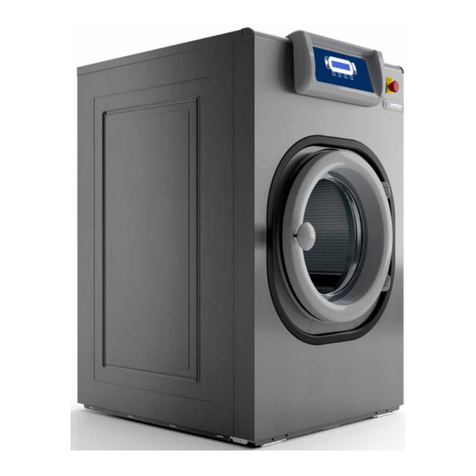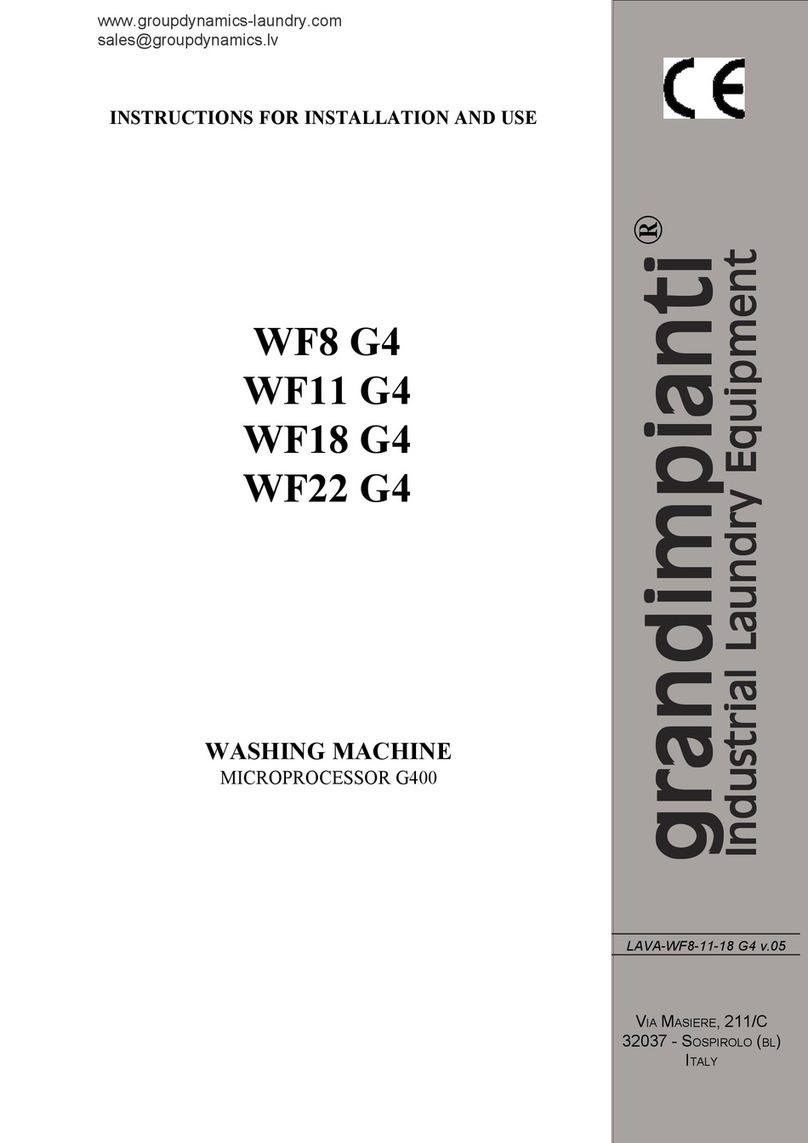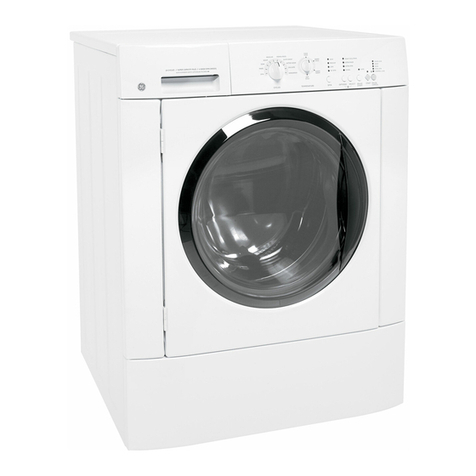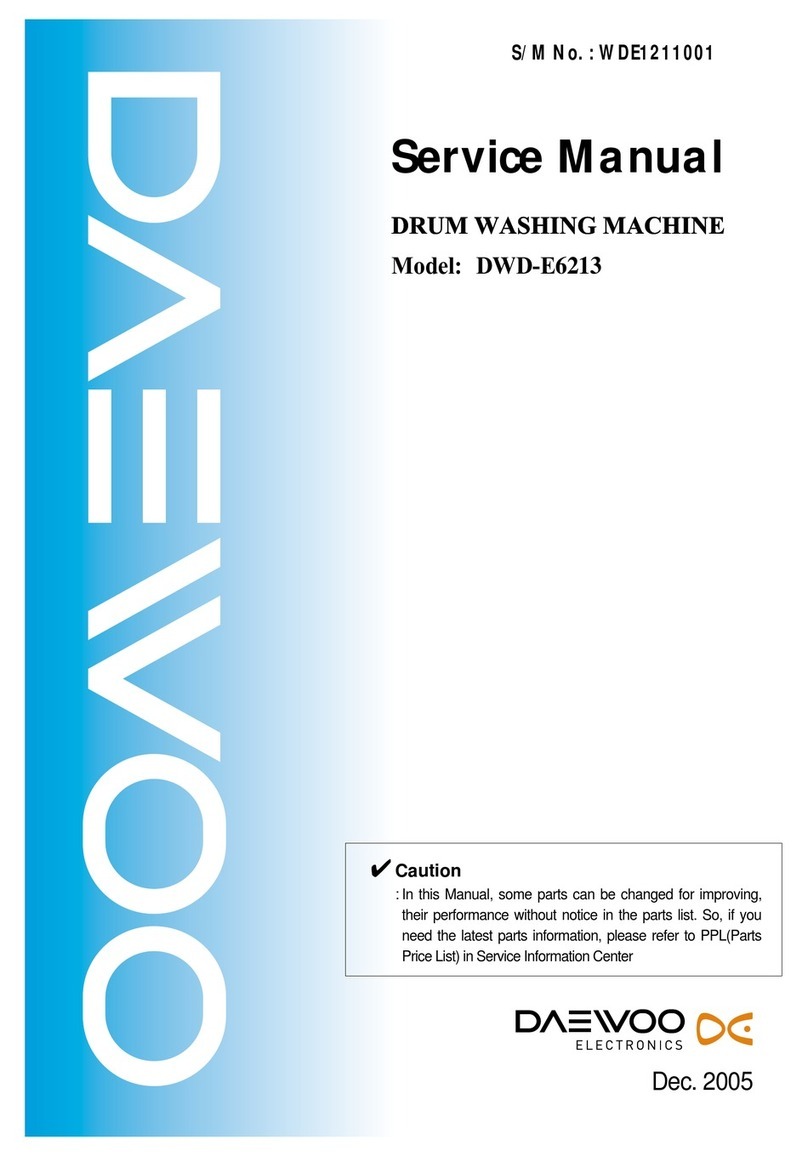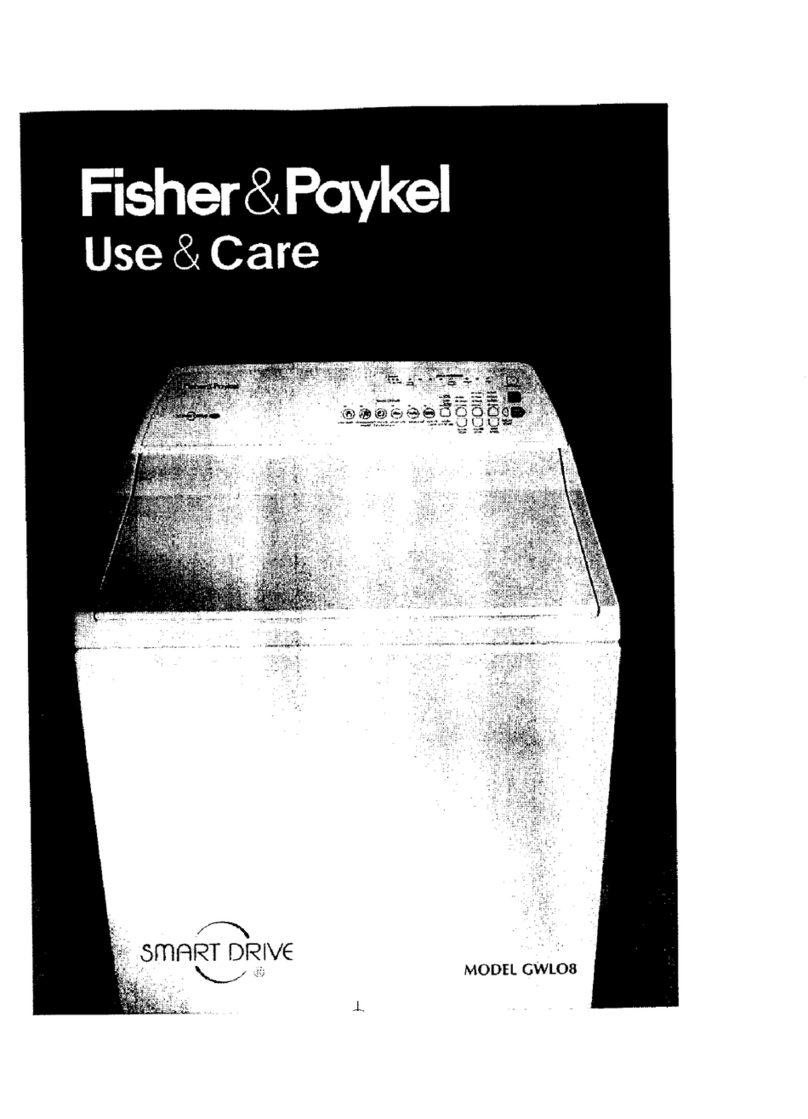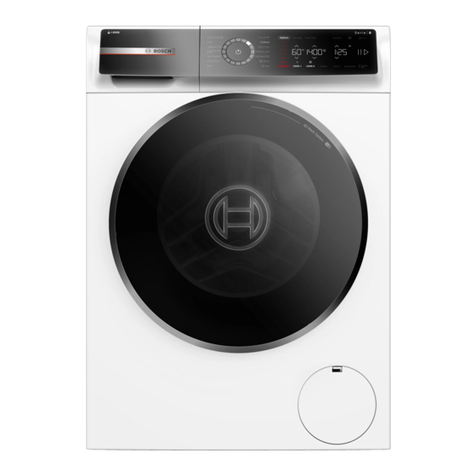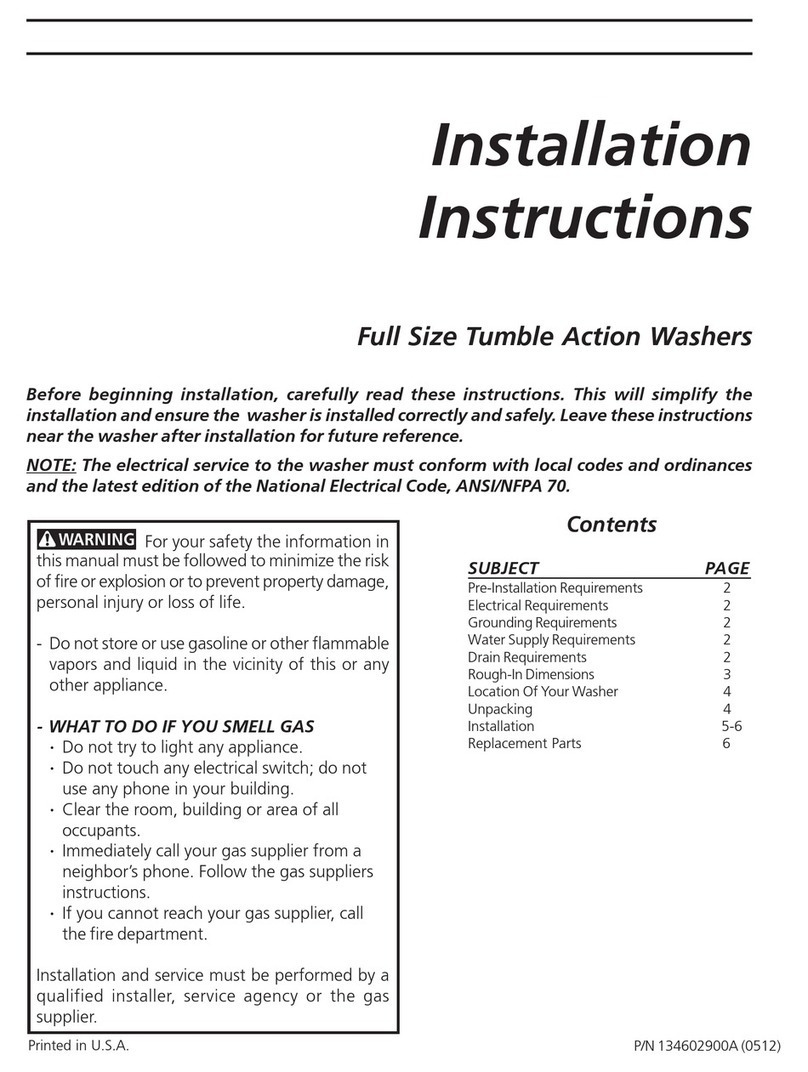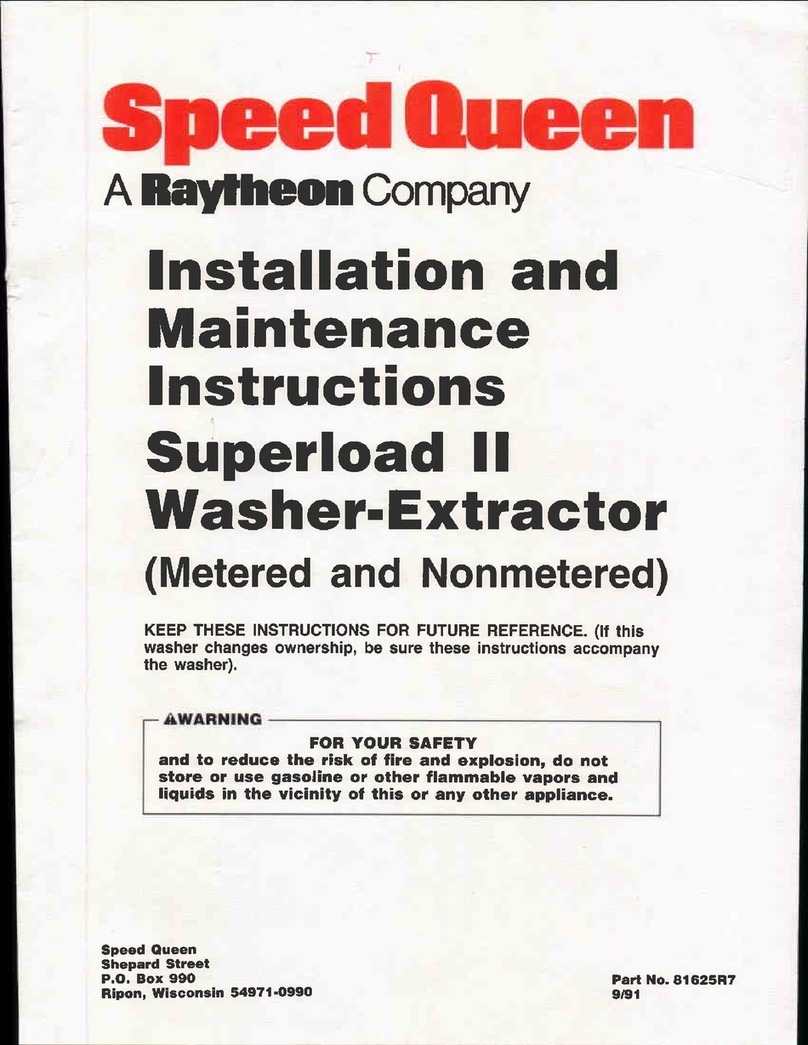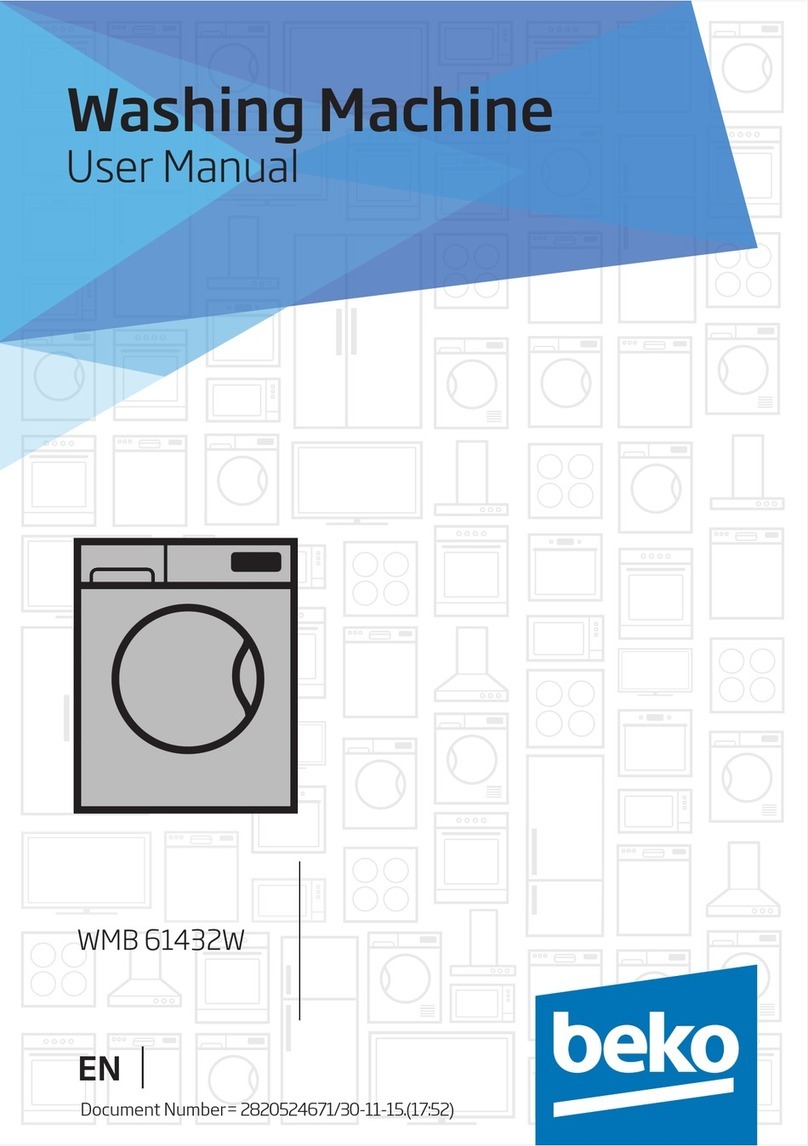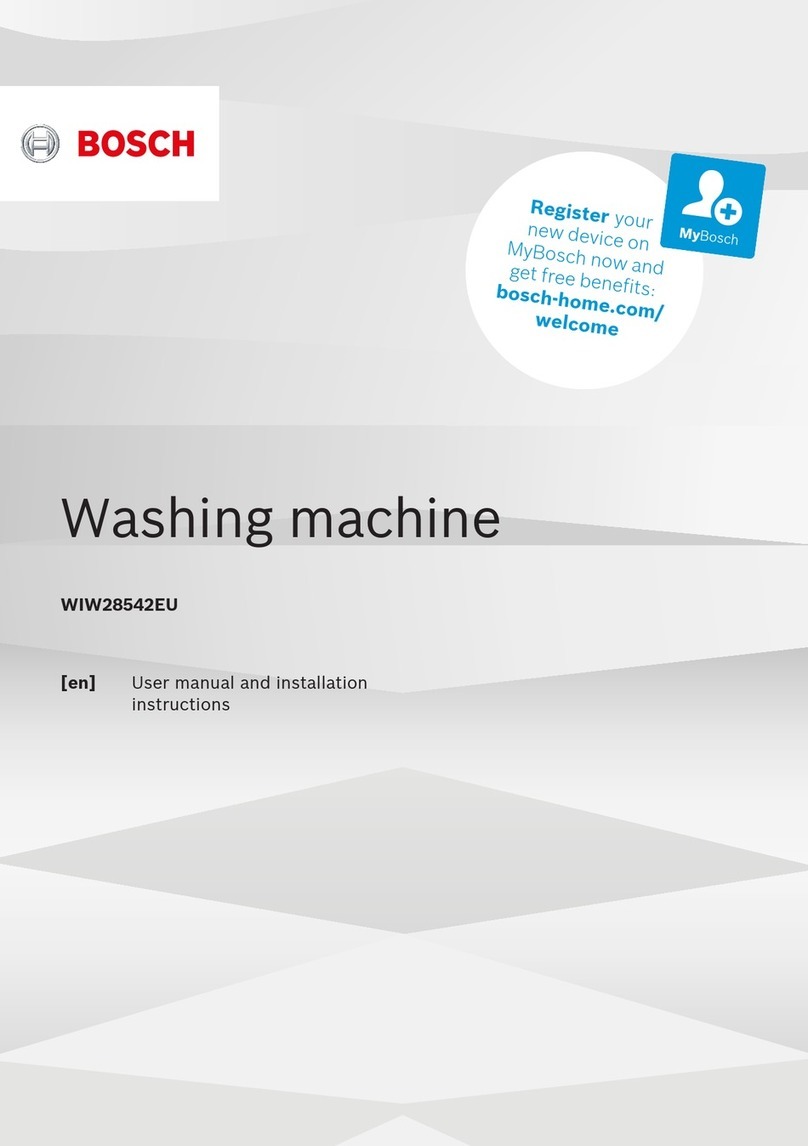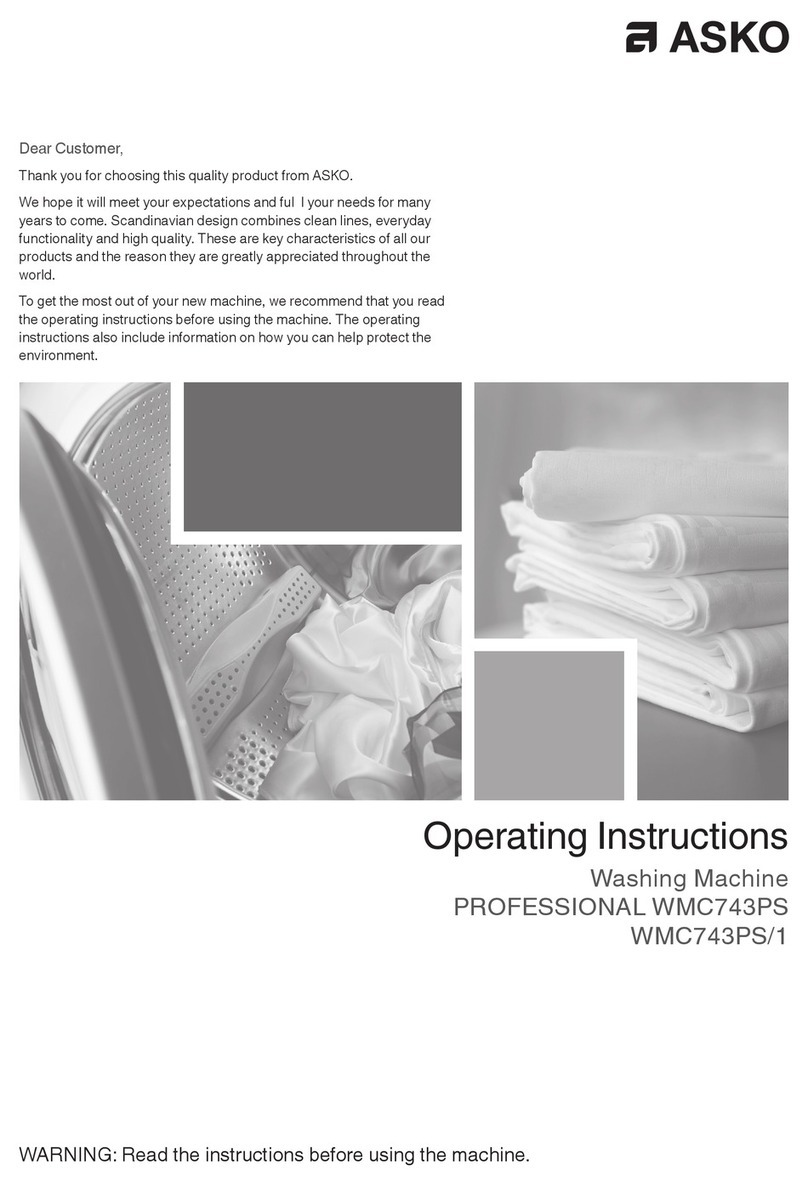grandimpianti WR 8 User manual

ZONA INDUSTRIALE
32037 - SOSPIROLO (BL)
ITALY
ISTRUZIONI PER L'INSTALLAZIONE E L'USO
INSTRUCTIONS FOR INSTALLATION AND USE
INSTRUCTIONS POUR L'INSTALLATION ET MODE D'EMPLOI
INSTALLATIONS- UND GEBRAUCHSANWEISUNG
INSTRUCCIONES PARA LA INSTALACIÓN Y PARA EL USO
LAVATRICE
PROGRAMMATORE A CAMME + MICROPROCESSORE
WASHING MACHINE
CAM CONTROL MODELS + MICROPROCESSOR
MACHINE À LAVER
PROGRAMMEUR À CAMMES + MICROPROCESSEUR
WASCHMASCHINE
PROGRAMMSCHALTER MIT NOCKEN + MIKROPROZESSOR
LAVADORA
PROGRAMADOR A LEVAS + MICROPROCESADOR
WR 8 - WR 11 - WR 18
WR 26 - WR 33
LAVA-WR.03
www.groupdynamics-laundry.com

www.groupdynamics-laundry.com

1
ISTRUZIONI PER L'INSTALLAZIONE E L'USO
INSTRUCTIONS FOR INSTALLATION AND USE
INSTRUCTIONS POUR L'INSTALLATION ET MODE D'EMPLOI
INSTALLATIONS- UND GEBRAUCHSANWEISUNG
INSTRUCCIONES PARA LA INSTALACION Y PARA EL USO
GB
I F
INDICE Pagina
1) Garanzia .....................................................2
2) Introduzione ...............................................2
3) Prescrizioni, divieti, ed usi diversi
della macchina............................................2
ISTRUZIONI PER L’INSTALLATORE
4) Indicazioni per il trasporto, disimballaggio,
movimentazione, immagazzinamento ........2
5) Indicazioni per la messa in servizio
della macchina............................................3
ISTRUZIONI PER L’OPERATORE
6) Indicazioni relative alla macchina ..............4
7) Indicazioni relative all’uso della macchina
e alla manutenzione ordinaria .....................4
ISTRUZIONI PER MANUTENTORE E
RIPARATORE
8) Indicazioni per la manutenzione straordi-
naria ed approvvigionamento pezzi di
ricambio .....................................................6
9) Indicazioni per la messa fuori servizio,
smantellamento, ed eliminazione della
macchina ....................................................6
Caratteristiche tecniche ............................29-34
Legenda componenti elettrici ........................35
Schema elettrico circuito ausiliario di
principio ...................................................40-42
Schema temporizzatore .................................43
Esplosi...........................................................44
INDEX Page
1) Guarantee ...................................................7
2) Introduction ................................................7
3) Instructions, things not to do and other
uses of the appliance ..................................7
INSTRUCTIONS FOR THE INSTALLER
4) Information about transport, unpack-
ing, moving, storage of the appliance .........7
5) Information regarding the installation of
the appliance ..............................................8
INSTRUCTIONS FOR THE USER
6) Information regarding the appliance ...........9
7) Information regarding the use and ordi-
nary maintenance of the appliance .............9
INSTRUCTIONS FOR STAFF RESPONSIBLE
FOR MAINTENANCE AND REPAIR WORKS
8) Information about scheduled mainte-
nance and provision of spare parts............11
9) Information on how to dismantle and
dispose of the appliance............................11
Technical data ..........................................29-34
List of electrical components.........................36
Main wiring diagram of auxiliary circuit..40-42
Timer diagram ...............................................43
Exploded drawings ........................................44
INDEX Page
1) Garantie....................................................12
2) Introduction ..............................................12
3) Prescriptions, interdictions, utilisations
diverses de l'appareil ................................12
INSTRUCTIONS POUR L'INSTALLATEUR
4) Indications p. transport, déballage, mise
en place, stockage de l'appareil.................12
5) Indications pour la connexion de
l'appareil ...................................................13
INSTRUCTIONS POUR L'UTILISATEUR
6) Informations sur l'appareil ........................14
7) Indications pour l'utilisation et l'entre-
tien de l'appareil .......................................15
INSTRUCTIONS POUR LE PERSONNEL
RESPONSABLE DE L'ENTRETIEN ET
RÉPARATIONS
8) Indications pour l'entretien extraordi-
naire et l'acquisition pièces détachées .......16
9) Indications pour mise hors service, dé-
montage et l'élimination de l'appareil .......16
Données techniques..................................29-34
Légende des composants électriques .............37
Schéma él. de principe circuit auxiliaire ...40-42
Schéma Horloge ............................................43
Vues éclatées .................................................44
E
INDICE Página
1) Garantía....................................................23
2) Introducción .............................................23
3) Prescripciones, prohibiciones y otros
usos de la máquina ...................................23
INSTRUCCIONES PARA INSTALADORES
4) Indicaciones sobre el transporte, el des-
embalaje, el desplazamiento y el depósito
de la máquina ...........................................23
5) Indicaciones para la puesta en servicio .....24
INSTRUCCIONES PARA UTILIZADORES
6) Indicaciones sobre la máquina...................25
7) Indicaciones sobre empleo de la máquina
y el mantenimiento ordinario....................26
INSTRUCCIONESPARALOSENCARGADOS
DEL MANTENIMIENTO Y REPARACIONES
8) Indicaciones para el mantenimiento
extraordinario y el abastecimiento de
repuestos ..................................................27
9) Indicaciones para la puesta fuera de ser-
vicio, el desmantelamiento y la elimina-
ción de la máquina....................................28
Datos técnicos ..........................................29-34
Leyenda componentes técnicos .....................39
Esquema el. circuito auxiliar de principio 40-42
Esquema temporizador ..................................43
Dibujos de repuestos .....................................44
INHALTSVERZEICHNIS Seite
1) Garantie ...................................................17
2) Einführung ...............................................17
3) Vorschriften, Verbote, verschiedene Hin-
weise für den Gebrauch des Gerätes........17
ANWEISUNGENFÜRDENINSTALLATEUR
4) Hinweise für Transport, Auspacken, Auf-
stellen und Lagern des Gerätes ................18
5) Hinweise für Inbetriebnahme ..................18
ANWEISUNGEN FÜR DEN BENUTZER
6) Hinweise zum Gerät ................................20
7) Hinweise für Gebrauch und Wartung
des Gerätes...............................................20
ANWEISUNGEN FÜR DEN WARTUNGS-
UND TECHNISCHEN KUNDENDIENST
8) Hinweise für die Instandhaltung des Ge-
rätes und Bestellung von Ersatzteilen......22
9) Hinweise für Außerbetriebnahme, Ab-
bau und Entsorgung des Gerätes .............22
Technische Daten ....................................29-34
Liste der elektrischen Einbauteile.................38
Schaltplan des Hilfsstromkreislaufs ........40-42
Schaltplan des Zeitschaltuhrs .......................43
Explosionszeichnungen ................................44
D
www.groupdynamics-laundry.com

2
ISTRUZIONI PER L'INSTALLAZIONE E L'USO
I
PREMESSA
Desideriamo ringraziarvi della preferenza
accordataci con l’acquisto della nostra
macchina. Siamo certi che otterrete le
migliorisoddisfazioniegaranzieseseguirete
attentamente le indicazioni contenute nel
presente manuale.
Vi informiamo inoltre che in qualsiasi caso
il testo di riferimento per eventuali
contestazioni o osservazioni rimane quello
inlinguaoriginaledelcostruttore,ovverosia
l’Italiano
1. GARANZIA
- La garanzia ha durata di mesi dodici (12) a
partire dalla data di acquisto dell’apparec-
chiature o parte integrante della stessa.
-Lagaranziaconsistenellasostituzionedel-
lepartieventualmentedifettoseperaccertate
cause di fabbricazione e viene applicata
direttamente dal vostro fornitore.
-Lamanod’operaèsempreacaricodell’ac-
quirentecome purelespeseditrasporto, im-
ballo e rischi di trasporto.
- La garanzia è subordinata alla restituzione
dei pezzi avariati in PORTO FRANCO ed
alla contemporanea comunicazione dei dati
riguardanti il modello, il numero di matri-
cola ed il difetto della macchina sulla quale
il particolare era montato.
- La garanzia non si applica alle apparec-
chiature che siano state danneggiate per
negligenza,erratocollegamento,installoin-
adatto, mancata osservanza delle istruzioni
dimontaggiooimpiegoecomunquealterate
dapersonalenonautorizzato.Nonsi applica
inoltre qualora il numero di matricola sia
stato alterato, cancellato o asportato.
-Nonsiapplicalagaranziasulseguentema-
teriale:
parti soggette alla normale usura quali cin-
ghie, membrane delle elettrovalvole e parti
in gomma in generale. Componenti elettrici
quali motore, bobine, contattori, resistenze
ecc.
2. INTRODUZIONE
Ilpresente manualeè statorealizzatoin mo-
dosemplicee razionale affinchéleggendolo
conosciate a fondo la vostra macchina. Si
raccomanda di leggere attentamente il con-
tenutoediconservarlounitamenteallamac-
china.Leavvertenzeeleattenzionicontenute
inquestomanuale,nonpossonocopriretutte
le eventualità; è importante tener presente
che buon senso attenzione e prudenza sono
fattorichenonpossonoessereaggiuntiall’ap-
parecchiatura da parte del costruttore, ma
devono essere previsti dalle persone che ef-
fettuanol’installazione la manutenzionee/o
usodellamacchina.Qualsiasipersonautilizzi
questa apparecchiatura dovrà leggere il pre-
sente manuale d’uso.
Incasodiinterventisullamacchinalapresente
dittaraccomandavivamentedi usare pezzidi
ricambio originali, per la cui ordinazione si
consiglia di consultare il paragrafo 8.
Le descrizioni ed illustrazioni contenute nel
presente manuale non si intendono impeg-
native; la ditta pertanto si riserva il diritto in
qualunquemomentoesenzaimpegno,diag-
giornare tempestivamente la pubblicazione
e/o di apportare eventuali modifiche ad or-
gani,componentieaccessori,nelcasoincui
questo venga ritenuto conveniente per un
miglioramento o per qualsiasi esigenza di
carattere costruttivo o commerciale.
3. PRESCRIZIONI, DIVIETI ED USI
DIVERSI DELLA MACCHINA
L’apparecchiaturadeveessereutilizzatasolo
da persone addestrate all’uso della stessa.
Disattivare la lavatrice in caso di guasto e/o
di cattivo funzionamento.
Durantel’uso lapuliziaelamanutenzionesi
deve fare attenzione a non accedere con ar-
nesietantomenoconlemaniapartiin movi-
mento (motore, cinghie). In caso di inciden-
ti la ditta costruttrice non si assume alcuna
responsabilità per danni all’operatore o ad
altripersonecheavvenganodurantel’uso,la
pulizia e la manutenzione della macchina.
Non aprire il dispenser durante il funziona-
mento per i detersivi in esso contenuto e per
la temperatura dell’acqua calda.
Questa apparecchiatura è stata progettata
per il lavaggio di tessuti secondo le indica-
zioniriportatesulleetichettedegliindumenti
o tessuti, lavare solo indumenti, biancheria
perlacasaetessutinormalidausoquotidiano.
Non inserite capi che siano stati a contatto
conprodottichimicioinfiammabilimaprov-
vedeteprimaad un lavaggioamano e asciu-
garliall’ariaperfarevaporarecompletamente
queste sostanze.
L’usodi qualunque apparecchioelettrico ed
elettronico comporta l’osservanza di alcune
regolefondamentali.Inparticolare:nontoc-
care l’apparecchio con mani e piedi bagnati
oumidi.Nonusarel’apparecchioapiedinu-
di, non lasciare esposto l’apparecchio agli
agenti atmosferici (pioggia, sale, salsedine,
etc.). Non permettere che l’apparecchio sia
usato da bambini o da incapaci senza una
adeguata sorveglianza. Non fumare in pros-
simità della lavatrice o durante l’uso. Non
rimuovere o scavalcare i dispositivi di sicu-
rezza.Nonutilizzaremaigettid’acquadiretti
od indiretti sulla macchina, fare attenzione
pertantoanoninstallarlainprossimitàdizo-
ne in cui è possibile questa evenienza.
OGNI ALTRO USO NON ESPLICITA-
MENTE INDICATO E’ DA CONSIDE-
RARSI PERICOLOSO. IL COSTRUT-
TORE NON PUÒ ESSERE RITENUTO
RESPONSABILE PER EVENTUALI
DANNI DERIVANTI DA USO IMPRO-
PRIO, ERRONEO ED IRRAGIONE-
VOLE.
ISTRUZIONI PER
L’INSTALLATORE
4. INDICAZIONI RELATIVE AL
TRASPORTO, DISIMBALLAGGIO ED
IMMAGAZZINAMENTO DELLA
MACCHINA
4.1. TRASPORTO MACCHINA
Se è necessario un eventuale trasporto e/o
spedizione della macchina è utile seguire
attentamente le seguenti raccomandazioni:
Qualora si debba trasportare l’apparecchia-
turaall’internodiunedificioutilizzareesclu-
sivamente l’apposito bancale o uno equi-
valente; utilizzare un carrello elevatore a
mano oppure elettrico idoneo al trasporto di
queste macchine e con capacità di solleva-
mentosufficiente(vedidatitecniciparagrafo
8). Controllare che la lavatrice possa su-
perare tutti gli ostacoli es. scale, porte etc.
Nontrascinate mai la macchina per i fianchi
o per qualsiasi altra parte.
Nel caso in cui la macchina debba essere
spedita utilizzare esclusivamente l’imballo
originale che aiuta a garantire sufficiente
stabilità alla macchina durante il trasporto.
4.2 IMMAGAZZINAMENTO
Qualora la macchina dovesse rimanere in
deposito per lungo tempo prima di essere
utilizzatalasciarlaall’internodelsuoimballo
originale il quale garantisce una ottima pro-
tezione.Assicurarsiinoltrechelecondizioni
ambientali siano corrispondenti a quelle di
cui al paragrafo 5. Nel caso in cui invece
debba rimanere ferma per lunghi periodi
dopo che è già stata usata; verificare che sia
materialmente scollegata dalla rete di
alimentazioneelettricaecoprirlaconilsacco
protettivo originale.
4.3 DISIMBALLAGGIO
1)Primadiprendereinconsegnalamacchina
dal trasportatore, controllare le condizioni
dell’imballo.Seilmedesimopresentadanni
evidenti all’esterno, può darsi che anche la
macchina abbia subito delle conseguenze.
In tal caso sballate la macchina in presenza
deltrasportatorestessoefirmate,conriserva,
la relativa bolletta di consegna. Eventuali
dannidovutialtrasportooaderratostoccag-
www.groupdynamics-laundry.com

3
gio non sono da attribuire alla casa costrut-
trice della macchina.
2)Disimballatelamacchinacontuttelecure
atteadevitaredidanneggiarla.Pertogliereil
bancale rimuovere le viti all’interno poste
sui fori di fissaggio al pavimento.
3) Aprire l'oblò (vedi paragrafo 7.2).
4) Verificate la presenza del seguente mate-
riale:2fascettemetalliche,1gomitoa90°in
gomma,2tubiflessibiliconghierada3/4,1*
filtroinottoneperl’ingressovapore,1*tubo
flessibilemetallico,dadi,rondelleespaccate
del diametro e numero delle zanche di fis-
saggio,dellechiavidiaperturadelcoperchio
(optional),dellechiavidelcassettogettonie
di15gettoni(solofunzionamentogettoniera)
(*solomacchineconriscaldamentovapore).
5) Accertatevi che non resti nell’imballo o
vada perduto il manuale di istruzioni.
Gli elementi dell'imballaggio (sacchetti di
plastica, polistirolo, legno, cartone, chiodi
etc.)nondevonoesserelasciatiassolutamente
alla portata dei bambini in quanto fonti di
potenziale pericolo; essi devono essere rac-
colti e conservati per eventuali futuri spos-
tamentidellamacchinaopereventualilunghi
periodi di fermo macchina (vedi paragr. 9).
Prima di collegare l’apparecchio accertarsi
cheidatiditargacorrispondanoallecaratte-
ristiche della rete elettrica a cui deve essere
collegatalamacchinastessa.L’apparecchio
dovrà essere destinato solo all’uso per il
quale è stato espressamente progettato.
5. INDICAZIONI PER LA MESSA IN
SERVIZIO DELLA MACCHINA
5.1. PRESCRIZIONI PER IL POSIZIO-
NAMENTO DELLA MACCHINA
Le lavatrici non presentano alcun problema
di ubicazione all’infuori di uno zoccolo
rialzato e livellato.
Mettere in bolla la macchina facendo uso di
una livella.
Se viene spostata l’apparecchiatura ripetere
l’operazione di livellamento.
Controllare il bloccaggio dei dadi sulle
zanche.
5.2. SPAZIO NECESSARIO PER L’IN-
STALLAZIONE, USO E MANUTEN-
ZIONE MACCHINA
La lavatrice dovrà avere a disposizione lo
spazio minimo indicato:
1) Fronte macchina
2) Scarico
3) Pannello controllo
4) Interruttoresezionatoreautomatico(non
compreso nella fornitura)*
5) Foriperfissaggioapavimento(conzan-
che fornite in dotazione)
6) Connessione per collegamento equipo-
tenziale a disposizione
7) Ingressoalimentazioneelettricacontubo
protettivo
8) Ingresso alimentazione acqua calda
9) Ingresso alimentazione acqua fredda
10) Ingressoalimentazionevapore(solocon
riscaldamento vapore)
11) Air Break
12) Dispenser
13) Oblò
14) Tirante di emergenza
15) Maniglia apertura porta
16) Zanche di fissaggio
17) Targa matricola
* La posizione dell'interruttore seziona-
tore automatico deve essere tale da poter
esserefacilmenteazionatodall’operatore
in una situazione di EMERGENZA (dis-
tanza massima mt 3).
5.3 CONDIZIONI AMBIENTALI CON-
SENTITEPERIL CORRETTO USODEL-
LAMACCHINA(dafarpresenteachiutiliz-
zerà la macchina)
- TIPO LOCALE: CHIUSO
- TEMPERATURAMINIMA:10°C(N.B.:
i componenti elettronici sotto tale tempe-
ratura possono avere un funzionamento
discontinuo)
- TEMPERATURA MASSIMA: 40°C
- UMIDITÀ RELATIVA: 75% U.R.
- ILLUMINAMENTO:100LUX(datova-
lidoperlo stato italiano,vista la nonomo-
geneità in materia di luminosità negli am-
bienti di lavoro per gli altri paesi è
necessario rifarsi alle singole leggi
nazionali.
5.4 OPERE MURARIE
Per il corretto funzionamento la lavatrice
deve essere ancorata al suolo tramite le
zanche che potrete trovare in dotazione.
Data l’elevata energia cinetica sviluppata in
centrifuga (vedi tabella sotto), per evitare
eccessivi rumori se ne sconsiglia la
sistemazione ai piani superiori.
Sceglietel’ubicazionedellalavatricesecondo
unalogicamovimentazionedellabiancheria,
compatibilmente con i problemi di impian-
tistica esistenti.
Predisponete uno scarico a pavimento, più
basso di quello della lavabiancheria, a una
distanza dalla macchina che ne consenta il
collegamento mediante il tubo a gomito
fornito in dotazione.
L’altezza dello zoccolo di cemento andrà
scelta in base all’altezza del carrello di
trasporto della biancheria affinché
quest'ultimoarriviallaboccadell'oblòsenza
ostacolarne l'apertura.
Procedereal getto del plinto di ancoraggio e
annegarelezanchedateindotazione,serven-
dosi,senecessario,diunasagomapreceden-
temente preparata.
Sette giorni dopo il getto posizionare la
macchina e fissarla con i dadi e le rondelle
fornite a corredo. Carico dinamico
Modello al suolo
Mod. 8 8874N 8Hz
Mod.11 11548N 8Hz
Mod.18 18250N 7Hz
Mod.26 28963N 7Hz
Mod.33 47566N 7Hz
5.5. COLLEGAMENTO ELETTRICO
L’installazione deve essere effettuata se-
condo le istruzioni del costruttore da perso-
naleprofessionalmentequalificatoeconfor-
memente alle norme sugli impianti elettrici
vigenti nei singoli paesi. Un’errata installa-
zionepuòcausaredanniapersone,animali o
cose, nei confronti dei quali il costruttore
non può essere considerato responsabile.
Peraccedereallamorsettieradiallacciamento
elettrico vedi paragrafo 7.3.
Accertarsi che la tensione di alimentazione
corrisponda ai dati di targa della lavatrice;
inoltreconsiderarechelevariazionimassime
consentite per la tensione di alimentazione
sono del ±10%.
IMPORTANTE:ÈOBBLIGATORIOCOL-
LEGARE LA MACCHINA A TERRA. A
questo scopo, all’interno, sulla morsettiera,
vièunmorsettoperilrelativocollegamento,
da eseguire secondo le norme di legge. Il
costruttore declina ogni responsabilità
qualoraquestanormaantiinfortunisticanon
venga rispettata.
In conformità alle più recenti norme anti-
infortunistiche la macchina è dotata di mor-
setto esterno per la connessione equipo-
tenziale a disposizione per il collegamento.
È indispensabile inserire a monte dell’ap-
parecchiaturauninterruttoreomnipolarese-
zionatore automatico con distanza minima
fra i contatti di 3 mm, tarato in base ai mas-
simi assorbimenti (vedi dati di targa della
apparecchiatura e tabella sotto):
Potenza totale
apparecchiatura Numero
dei poli Corrente
nominale In
Corr. diff.
d'inter-
vento Id
Riscaldam.
elettrico Riscaldam.
vapore 230/
3400/
3230/3 400/3
da 550
a 1100W 3 4 6 6 30 ma
da 1800
a 1850W 3 4 16 10 30 ma
da 6000
a 10000W 3 4 20-30 16 30 ma
da 10000
a 13000W 3 4 30-40 20 30 ma
da 18000
a 25000W 3 4 50-70 30-40 30 ma
Predisporre un tubo passacavo del diametro
esternodi20mmtral’interruttoresezionatore
e l’ingresso per l’alimentazione elettrica
dell'apparecchiatura. Essendo tale ingresso
dotato di uno stringitubo, dopo aver inserito
iltuborigidosarànecessarioavvitareildado
dall’interno della macchina. Utilizzare un
cavo del tipo indicato nella tabella che se-
gue, assicurandosi che il cavo sia non
propagante la fiamma ed opportunamente
protetto.Unavoltainseritoilcavoavvitareil
pressacavo all’interno dell'apparecchiatura.
www.groupdynamics-laundry.com

4
per il recupero della condensa.
Se la macchina a vapore è soggetta a con-
trollo ISPESL, occorrerà tenere sempre a
disposizione tutta la documentazione
ISPESL nei locali in cui è posizionata.
Verificareafinemontaggiochenonvisiano
strozzature nel tubo utilizzato.
5.8 COLLEGAMENTO SCARICO
Accertarsi che la distanza tra l’attacco dello
scarico della macchina e lo scarico a pavi-
mento non sia maggiore della lunghezza del
gomito di scarico fornito in dotazione.
Loscarico dell’acqua avvienemediante una
valvola motorizzata ad azione diretta, la
quale rimane aperta (per caduta) in assenza
ditensione.Loscaricopertantodovràessere
semprepiùbassodell’uscitadellalavatricee
di un diametro non inferiore a quello del
tubo dato in dotazione.
Modello Portata scarico
Mod. 8 80 l/min
Mod.11 100 l/min
Mod.18 160 l/min
Mod.26 160 l/min
Mod.33 200 l/min
Il condotto di scarico deve sopportare la
temperatura di 90°C.
Interporre un sifone tra il tubo dato in
dotazione e lo scarico.
Verificare che non ci siano strozzature.
5.9 AIR BREAK
La lavatrice è dotata del dispositivo "air
break" che in caso di depressioni nella rete
impedisce il ritorno di acqua non potabile .
Taledispositivoprevedeun’uscitaposteriore,
dallaquale,duranteilriscaldamento,possono
fuoriuscire dei vapori comunque innocui.
Non tappare né raccordare tale uscita in
nessun caso.
LA GARANZIA NON RISPONDE DEI
DANNI DERIVANTI DA UN'ERRATA
INSTALLAZIONE.
ISTRUZIONI PER
L’OPERATORE
6. INDICAZIONI RELATIVE ALLA
MACCHINA
6.1 DESCRIZIONE DELLA MACCHINA
Lamacchinaècompostadalleseguentiparti
principali:
1) Coperchio sotto il quale è collocato il
circuito di comando
2) Dispenserdovevaintrodottoildetersivo
per il prelavaggio e il lavaggio (in
polvere,nonschiumogeno)eperl’ultimo
risciacquo (liquido, non schiumogeno).
3) Oblò per il carico della biancheria
4) Pulsantiera per la selezione del ciclo
5) Indicatore situazione ciclo
6) Lampada consenso apertura porta
7) Interruttore generale
8) Pulsante di start e avanzamento ciclo
9) Selettore 2 o 4 risciacqui
10) Gettoniera *
11) Lampada spia *
12) Pulsante avanzamento ciclo *
(* solo per funzionamento gettoniera)
IMPORTANTE: GLI SCHEMI RI-
PORTATI SUCCESSIVAMENTE SO-
NOINDISPENSABILIPERLARICER-
CAEL’ORDINAZIONEDELLEPARTI
DI RICAMBIO.
6.2. GAMMA COMPLETA DELLE AP-
PLICAZIONI
Lalavatriceche avete acquistatoèstata pro-
gettata in modo da eseguire il lavaggio di
tessuti sintetici di vario genere, di capi in
lana, cotone e lino. Il ciclo deve essere
opportunamente selezionato tramite la
pulsantiera e in considerazione delle
temperature indicate sulle etichette dei capi
da lavare.
6.3. INFORMAZIONI SULL’IMPIANTO
ELETTRICO
L’impianto elettrico a bordo macchina è
composto da apparecchiature di protezione
e controllo opportunamente inserite su una
piastranellapartesuperioredella macchina.
Glischemieledistinterelativesonoriportati
successivamente.
6.4. DOCUMENTI ATTESTANTI LA
CONFORMITÀ DELLA MACCHINA
Lalavatricedescrittanelpresentemanualeè
conforme alle seguente direttive:
73/23/CEE, 93/68/CEE, 89/336/CEE
92/31/CEE
e normative:
EN 60335, EN 61000, EN55014
7. INDICAZIONI RELATIVE ALL’USO
DELLA MACCHINA
7.1 FUNZIONAMENTO
Dare tensione all’apparecchiatura agendo
sull’interruttore sezionatore generale a pa-
rete.
Commutarel’interruttoregeneraledellamac-
china in posizione 1.
Aquesto punto se l’oblò è chiuso si accende
la spia di apertura porta.
Controllate che siano aperti i rubinetti
dell’acqua calda e fredda e del vapore (sulle
macchineconquestotipodiriscaldamento).
Le temperature vanno impostate tenendo
conto della simbologia comunmente usata
dalle industrie tessili e raffigurata nelle
etichette dei capi.
Separatiicapidalavare,premereil pulsante
diaperturaporta(neimodellisprovvistiagire
direttamente sulla maniglia) e caricare il
cesto (vedi anche paragrafo 7.5).
Potenza totale
apparecchiatura Numero
conduttori Tipo di cavo Sezione di ogni
conduttore mm2 Diam.
tubo Misura
pressacavo
Riscaldam
.elettrico Riscaldam.
vapore 230/
3400/
3230/3 400/3 230/3 400/3 mm Pg
da 550 a
1100W 45
H05V
V-F H05V
V-F 1 1 16 16
da 1800 a
1850W 45
H05V
V-F H05V
V-F 2,5 1,5 16 16
fino a
7000W 45
H05V
V-F A07V
V-F 2,5 1,5 16 16
fino a
13000W 45
A07V
V-F A07V
V-F 6 2,5 20 21
fino a
19000W 45
A07V
V-F A07V
V-F 10 6 20 21
fino a
25000W 45
A07V
V-F A07V
V-F 16 10 25 29
L'alimentazione della lavatrice deve
rispettare il senso ciclico delle fasi R-S-T
(A1-A2-A3)(L1-L2-L3),alfinedinonrecare
danni all'apparecchiatura stessa. La verifica
del senso ciclico può essere fatta anche
manualmente nel seguente modo:
- Allacciare le tre fasi, il neutro e la terra.
-Accendere l’interruttore sezionatore gene-
raleaparete;schiacciarequindimanualmente
il teleruttore della centrifuga. Se il senso di
rotazione è orario le fasi sono connesse
correttamente; in caso contrario invertire
due delle fasi in entrata.
IMPORTANTE:Comunicarealclienteo
all’utilizzatore o al responsabile tecnico
dell’impiantodilavanderia l’importanza
delcorrettosensociclicodellefasiinmodo
da evitare che possano venire invertite
accidentalmente.
5.6 COLLEGAMENTO IDRICO
Lalavabiancheriaèpredispostaperun'entrata
d'acqua calda (circa 60°C) e un'entrata d'ac-
qua fredda, entrambe da 3/4".
Lapressionedell’acquainentratadeveessere
compresa tra 0,5 e 8 bar (0,05 e 0,8 MPa).
Predisporre gli attacchi a parete ad una
distanzachenonsuperilalunghezzadeitubi
dati in dotazione.
Se non vi è acqua calda a disposizione,
predisporre una ‘T’ sull’attacco dell’acqua
freddaecollegarel’attacco dell’acqua calda
con l’acqua fredda. In qualsiasi caso vanno
alimentati entrambi gli ingressi.
Modello Capacità boiler
Mod. 8 45 litri
Mod.11 58 litri
Mod.18 100 litri
Mod.26 146 litri
Mod.33 190 litri
Verificareafinemontaggiochenonvisiano
strozzature nei tubi utilizzati.
5.7 COLLEGAMENTO VAPORE (SOLO
PERLEMACCHINECONQUESTOTIPO
DI RISCALDAMENTO)
La lavabiancheria è predisposta per un’en-
trata di vapore da 3/4". La pressione del va-
pore in entrata deve essere compresa tra 0,5
e 6 bar (0,05 e 0,6 MPa). In qualsiasi caso
leggere i dati di targa dell’apparecchiatura.
Il vapore è da intendersi saturo e secco.
Il riscaldamento dell’acqua nella vasca
avviene in modo diretto (non tramite una
serpentina, indiretto) pertanto nell’impian-
tistica non è necessario prevedere l’attacco
www.groupdynamics-laundry.com

5
Caricareil detersivo (nonschiumogeno)nei
relativi scomparti a seconda del ciclo da
selezionare: scomparto A per il prelavaggio
(se previsto), scomparto B per il lavaggio,
scomparto C per eventuali additivi da ag-
giungere all’ultimo risciacquo (vedi anche
paragrafo 7.5).
Selezionare il numero di risciacqui deside-
rato.
Selezionare il ciclo adatto alla biancheria,
quindi premere il pulsante verde di START
erilasciarlo.Lemacchineconfunzionamento
gettoniera si avviano con l'inserimento dei
gettoni richiesti.
A fine ciclo si illumina nuovamente la spia
di apertura porta (vedi paragrafo 7.2).
7.2 APERTURA PORTA
Afineciclosiaccende lalampadadiapertura
porta. Per aprire la porta impugnare la
maniglia e tirare la maniglia verso se stessi
tenendo premuto il pulsante centrale.
In caso di mancanza di tensione, la lavatrice
ha un dispositivo elettronico che sblocca la
portadopo90sec..Secosìnonfosse, togliere
il frontale inferiore e abbassare il tirante
manuale.
Comunqueprimadiaprirelaportaaccertarsi
che il cesto sia fermo, l'acqua sia stata
scaricata e che la temperatura interna sia
inferiore ai 40°C.
7.3 TOGLIERE IL COPERCHIO
Per accedere alla parte elettrica della
macchina togliere le viti di fissaggio con la
schiena e con il dispenser quindi alzare la
parte posteriore del coperchio e spingerla
verso il frontale di 5 cm circa.
RIPOSIZIONARETUTTIIPANNELLI
EVENTUALMENTERIMOSSIPRIMA
DI DARE TENSIONE ALLA MAC-
CHINATRAMITEL’INTERRUTTORE
SEZIONATORE GENERALE A PA-
RETE.
7.4 PROGRAMMI DI LAVAGGIO
CICLO 1:
-Prelavaggioabassolivello,detersivoscom-
parto A, riscaldamento a 45°C e centrifuga
breve.
- Lavaggio a basso livello, detersivo scom-
parto B, riscaldamento a 90°C, raffredda-
mento ad alto livello e scarico.
- 2 o 4 risciacqui ad alto livello con centri-
fughe intermedie brevi.
- Risciacquo finale ad alto livello, detersivo
scomparto C e centrifuga finale di 5 min.
CICLO 2:
- Prelavaggio a basso livello, detersivo
scomparto A, riscaldamento a 30°C e
centrifuga breve.
- Lavaggio a basso livello, detersivo
scomparto B, riscaldamento a 60°C,
raffreddamento ad alto livello e scarico.
- 2 o 4 risciacqui ad alto livello con centri-
fughe intermedie brevi.
- Risciacquo finale ad alto livello, detersivo
scomparto C e centrifuga finale di 5 min.
CICLO 3:
-Prelavaggioadaltolivello,detersivoscom-
parto A, riscaldamento a 30°C e scarico.
- Lavaggio ad alto livello, detersivo
scompartoB,riscaldamentoa45°Cescarico.
- 2 o 4 risciacqui ad alto livello.
- Risciacquo finale ad alto livello, detersivo
scomparto C e centrifuga finale breve.
CICLO 4:
- Lavaggioadaltolivello,detersivoscompar-
to B, riscaldamento a 30°C e scarico.
- 2 o 4 risciacqui ad alto livello.
- Risciacquo finale ad alto livello, detersivo
scomparto C e centrifuga finale breve.
CICLO 5:
- Lavaggio ad alto livello, detersivo
scomparto B e scarico.
- 2 o 4 risciacqui ad alto livello.
- Risciacquo finale ad alto livello, detersivo
scomparto C e centrifuga finale breve.
Primadilavarequalsiasicapofareattenzione
che gli eventuali bottoni, cerniere, zip/zap,
fermagliefibbiesianorivoltiversol’interno.
Controllare anchecheletaschesianovuote.
Al termine del lavoro eseguire le seguenti
operazioni:
- lasciare l’oblò aperto;
-toglieretensioneall’apparecchiaturatramite
l’interruttore generale;
-chiudereirubinettidell’acquacalda,fredda
edelvapore(sullemacchineconquestotipo
di riscaldamento);
-spegnerel’interruttoresezionatoregenerale
a parete.
7.5CONSIGLIUTILIPERL’USODELLA
MACCHINA
Ricordarecheuncaricodell’80%dellacapa-
citàdichiaratagarantisceunaqualitàmigliore
del lavaggio.
Ricordareunaquantitàmaggioredidetersivo
non significa un qualità di pulito migliore,
ma anzi uno spreco con conseguente inqui-
namento inutile. La quantità di detersivo vi
sarà consigliata dal vostro fornitore nella
quantità prevista per la durezza dell’acqua
che utilizzate.
7.6 RACCOMANDAZIONI
Non lasciare l’apparecchio inutilmente
inserito.SPEGNERE l’interruttoregenerale
dell’apparecchio quando lo stesso non è
utilizzato.
Nell’uso porre particolare attenzione a:
- Aprire l’oblò solo a cesto fermo e senza
acqua.
-Incasodi mancanza ditensioneè possibile
aprirel’oblòtramite il tirantemanualeposto
nella parte inferiore sinistra, prima di utiliz-
zarlo verificare che l’acqua sia uscita, il ce-
sto fermo e la temperatura inferiore a 40°C.
- Prima di effettuare qualsiasi operazione di
pulizia o manutenzione, accertarsi che i
rubinetti acqua calda, fredda e del vapore
(nelle macchine con questo tipo di
riscaldamento) siano chiusi e l’interruttore
generale a parete risulti spento.
-Noninserirenell’apparecchiaturabianche-
riachesiastatapulita,bagnata,lavataomac-
chiataconsostanzeinfiammabilioesplosive.
Altrimentiprocedere prima conunlavaggio
a mano.
- Tenere liquidi infiammabili lontano dalla
lavatrice e conservarli in luogo asciutto ben
arieggiato e lontano da zone accessibili a
personale non addetto.
- Tenere i prodotti per la pulizia e i detersivi
semprelontanidallaapparecchiatura,possi-
bilmente chiusi in un armadio.
- Non ostruire le aperture o fessure di aspi-
razione o di smaltimento calore, mantenere
quindiunaadeguatadistanzatralamacchina
e le pareti o altri oggetti.
7.7 INFORMAZIONI SU SISTEMI
PARTICOLARI PER L’USO E PER LA
PROTEZIONE.
Nelprimo ciclodi utilizzoverificare quanto
segue:
-Levaschettedeldetersivodevonorimanere
pulite.
• La vaschetta A dopo il carico acqua per il
prelavaggio (solo cicli 1, 2, 3);
• La vaschetta B dopo il carico acqua per il
lavaggio;
• La vaschetta C dopo il carico acqua
dell'ultimo risciacquo.
-Controllare cheleeventualisolidificazioni
di detersivo prodotte durante lo stoccaggio
vengano rimosse.
-Eseguite un cicloa 90°C per togliereeven-
tuali residui di lavorazione.
- L'operatore deve riuscire a controllare il
dispenser comodamente; se è troppo basso
siconsigliadicostruireunapedanaadeguata.
-Verificatecheicarrelliperiltrasportodella
biancheriasianopiùbassidellimiteinferiore
dell'oblò.
- Sistemate eventualmente un paracolpi af-
finché i carrelli non vadano mai a colpire
l'oblò danneggiandolo.
- Non aprire mai il dispenser durante il
carico acqua o il riscaldamento.
7.8 MANUTENZIONE ORDINARIA A
CURA DELL’OPERATORE
PRIMADIQUALSIASIOPERAZIONE
DI MANUTENZIONE TOGLIERE
TENSIONE ALLA MACCHINA TRA-
MITE INTERRUTTORE SEZIONA-
TORE GENERALE A PARETE, CHIU-
DERE I RUBINETTI DELL’ACQUA
CALDA, FREDDA E DEL VAPORE
(NELLE MACCHINE CON QUESTO
TIPO DI RISCALDAMENTO) E
www.groupdynamics-laundry.com

6
VERIFICARECHELAVASCAABBIA
SCARICATO L’ACQUA, IL CESTO
SIA FERMO E LA TEMPERATURA
INTERNA SIA INFE-RIORE AI 40°C.
L’apparecchiaturanonrichiede una partico-
lare manutenzione grazie al design ergono-
mico e all’utilizzo di componenti affidabili
di prima qualità.
Periodicamente lavare i pannelli di rivesti-
mentoconunostraccioumido;nonutilizzare
assolutamente prodotti infiammabili o ab-
rasivi seguire la direzione della satinatura.
NON USARE MAI GETTI D’ACQUA
PERLAPULIZIADELLAMACCHINA.
RIPOSIZIONARETUTTIIPANNELLI
EVENTUALMENTERIMOSSIPRIMA
DIDARETENSIONEALLAMACCHI-
NA TRAMITE INTERRUTTORE SE-
ZIONATOREGENERALEAPARETE.
ISTRUZIONI PER IL
MANUTENTORE ED IL
RIPARATORE
8. INDICAZIONE PER LA MANUTEN-
ZIONESTRAORDINARIAEL'APPROV-
VIGIONAMENTO DI PEZZI DI
RICAMBIO
8.1 ISTRUZIONI PER LA LOCALIZ-
ZAZIONE DEI GUASTI.
• In caso di non funzionamento della mac-
china verificare quanto segue:
- l’interruttore sezionatore generale a parete
è inserito e arriva tensione alla macchina;
- l’oblò è chiuso;
- l’interruttore dell’apparecchiatura è in
posizione 1;
- è stato premuto il pulsante verde di Start;
-irubinettidell’acquacalda,freddaedelva-
pore (nelle macchine con questo tipo di ris-
caldamento) sono aperti.
Qualora il difetto sussista anche dopo aver
verificatoed eventualmente eseguitoqueste
operazioni, chiamare il centro di assistenza
autorizzato o in alternativa il nostro
rivenditore(vediultimapaginadelmanuale).
• La centrifuga avviene in senso antiorario:
-assicurarsichel’entedidistribuzionedell’e-
nergia elettrica non abbia invertito le fasi
dell’alimentazione trifase in ingresso al vo-
stro edificio, nel qual caso farle ripristinare
dal nostro centro di assistenza tecnica o da
un elettricista esperto.
Qualora il difetto sussista anche dopo aver
verificatoed eventualmente eseguitoqueste
operazioni, chiamare il centro di assistenza
autorizzato o in alternativa il nostro
rivenditore(vediultimapaginadelmanuale).
8.2 SICUREZZE
- Micro di sicurezza porta chiusa che stacca
l’alimentazione a tutto il circuito ausiliario
fermando la macchina.
- Interruttore termico all’interno del motore
che interrompe l’alimentazione in caso di
surriscaldamento sugli avvolgimenti.
- Sistema "Air-Break" nel dispenser, che
evital’inquinamentodellareteidricaincaso
di depressioni.
- Valvola di scarico normalmente aperta per
lo scarico dell'acqua, affinché l’operatore
possaaprirel'oblòmediante tirantemanuale
senza correre rischi.
8.3 MANUTENZIONE PERIODICA A
CURA DEL PERSONALE TECNICO
Qualsiasi operazione di manutenzione va
effettuata dai centri di assistenza autorizzati
dai nostri rivenditori o da personale qualifi-
cato.
PRIMADIQUALSIASIOPERAZIONE
DI MANUTENZIONE TOGLIERE
TENSIONE ALLA MACCHINA TRA-
MITE L'INTERRUTTORE SEZIONA-
TOREGENERALEAPARETEECHIU-
DERE I RUBINETTI DELL’ACQUA
CALDA, FREDDA E DEL VAPORE
(NELLE MACCHINE CON QUESTO
TIPO DI RISCALDAMENTO).
Porre sempre una particolare attenzione du-
rante la manutenzione. Non escludere MAI
sicurezze per nessun motivo, utilizzare ri-
cambi originali, in caso di qualsiasi dubbio
consultaretempestivamenteilnostroufficio
tecnico,comunicandoilmodello eilnumero
di matricola rilevabili dalla targhetta posta
sul retro della lavatrice.
CONTROLLO MENSILE
Controllare che i filtri delle elettrovalvole
inseritinellaparteesternadellavalvolasiano
puliti
Controllare che il filtro dell’elettrovalvola
vapore sia pulito (nelle apparecchiature con
questo tipo di riscaldamento).
Pulire il dispenser da eventuali residui di
detersivo.
Pulireconunpannolaguarnizionedell’oblò
e la relativa bocca della vasca.
CONTROLLO ANNUALE
Controllare la chiusura dei dadi di chiusura
delle zanche.
Controllarelostato di usuradellecinghie ed
eventualmentesostituirle;sepiùdiunasosti-
tuire il set intero.
Verificareilbuonfunzionamentodellesicu-
rezze, come ad esempio i micro della
serratura.
Verificare la chiusura delle viti di fissaggio
al pavimento.
Verificareilserraggiodellevitidiconnessio-
neelettricadipotenzasuteleruttoriemorset-
tiera di ingresso.
Smontarelavalvoladiscaricoepulirlainter-
namente dai filacci.
Controllareilfunzionamentodelleresistenze
e pulirle da incrostazioni calcaree.
RIPOSIZIONARETUTTIIPANNELLI
EVENTUALMENTERIMOSSIPRIMA
DIDARETENSIONEALLAMACCHI-
NATRAMITEL'INTERRUTTORESE-
ZIONATOREGENERALEAPARETE.
8.4 RICERCA E ORDINAZIONE DEI
PEZZI DI RICAMBIO
Per l’identificazione dei codici dei pezzi di
ricambioutilizzareidisegniesplosiconrela-
tivedistintedelleparti.Unavoltaidentificati
i codici inviare regolare ordine scritto alla
ditta costruttrice indicando chiaramente il
modello dell’apparecchiatura, il numero di
matricola, la tensione di alimentazione e la
frequenza, oltre naturalmente al codice e
descrizione della parte di ricambio che
interessa.
9.INDICAZIONIPERLAMESSAFUORI
SERVIZIO, SMANTELLAMENTO, ELI-
MINAZIONE DELLA MACCHINA
Allorchési decida di non utilizzare più l’ap-
parecchiatura,si raccomanda di renderla in-
operante eliminando opportunamente i ma-
terialie tenendo presente quanto già detto al
paragrafo 3. In conformità alle norme per lo
smaltimento dei rifiuti vigenti nei singoli
paesi e per il rispetto dell’ambiente in cui
viviamo, vi preghiamo di dividere le parti
della macchina in modo da poterle smaltire
separatamenteorecuperareopportunamente.
Tutte le parti componenti la macchina sono
assimilabili ai rifiuti solidi urbani fatta
eccezione per le parti metalliche che
comunque non sono iscritte tra i rifiuti
specialinellamaggiorpartedeipaesieuropei.
www.groupdynamics-laundry.com

7
FOREWORD
Congratulations on your selection of our
washing machine. If you follow carefully
thepresentinstructionsyouwillcertainlybe
satisfiedwithitsperformanceandguarantee.
In the event of claims or remarks, the refer-
ence text remains the original one in the
manufacturer’s native language, that is, the
Italian version.
1. GUARANTEE
-The guarantee has a validity of twelve (12)
monthsstartingfrom the dateofpurchase of
the appliance or of any integral part of it.
- The guarantee covers the substitution of
any defective parts which are ensured as
havingbeencausedduringmanufacture.The
warranty is applied directly by your dealer.
-Labour costs are always atto be met by the
purchaser,aswellastransport,cratingcosts,
and transport risks.
- The guarantee is subordinated to the re-
stitutionof damaged parts,which have tobe
sent CARRIAGE PAID including all data
concerning the appliance, such as model,
serial number and defect of the machine
ontowhichthedamagedpartwasassembled.
- The guarantee is not valid if the appliance
has been misused or if there have been mis-
takesin the electrical connections, wrong or
inappropriate installation, regardlessness of
the instructions given concerning assembly
and use or changes carried out by unauthor-
isedpersons.Theguaranteeisvoidwhenthe
serial number has been scratched or taken
off or altered in any way.
-Theguaranteeisnotvalidforthefollowing
items: parts which are subject to a normal
wearlikebelts, valvemembranesandrubber
parts in general, electric components like
motor, coils, contactors, heaters and so on.
2. INTRODUCTION
The present booklet has been formulated in
a simple and rational way, in order for the
reader to get deeply acquainted with the
washingmachine.Please,readcarefullyand
keepwiththe machine. However, thewarn-
ing and advice contained in this manual
cannot cover every possible contingency.
This is why it is important to underline that
common sense, carefulness and caution
cannot be supplied by the manufacturer, but
must be provided by those in charge of its
installation, maintenance and use.
Whoever operates the machine must
have read this manual beforehand.
In case of repairs, the manufacturer recom-
mendstheuseoforiginalspareparts.Orders
are dealt with in chapter 8.
The descriptions and sketches reported in
this manual do not bind the manufacturer,
who reserves the right to update them and/
or include any upgrading modification of
parts and fittings if deemed necessary for
manufacturing or commercial purposes, at
any time and with no previous notice.
3. PRESCRIPTIONS, RESTRICTIONS
AND OTHER USES
The washing machine must be operated by
trained personnel only.
Disconnect it in case of malfunction and/or
faulty operation.
During use, cleaning and maintenance it is
absolutely necessary to be sure that tools or
hands are never stuck in the moving parts of
the appliance (motor, belts, etc.).
Themanufacturerassumesnoresponsibility
for any personal injury arising while using,
cleaning or servicing the washing machine.
Do not open the soap dispenser while the
applianceisrunning,becauseofthesubstance
containedandalsobecauseofthetemperature
of water.
This machine was designed to wash fabrics
according to the instructions of the labels,
appearing on garments. Wash only cloths,
household linen and ordinary fabrics.
Do not load the machine with fabrics that
have been in contact with inflammable or
chemical products. Otherwise, hand-wash
them first, and then air-dry to let those
substances evaporate.
The operation of any electric or electronic
appliance entails compliance with certain
basic rules and in this case particularly: do
not touch the machine with damp or wet
handsorfeet;donotuseitwhilebare-footed,
do not expose it to atmospheric agents like
rain, salt, salinity, etc. Do not allow its
operation by children or disabled persons
without proper supervision. Do not smoke
nearthemachineorduringoperation;donot
remove or ignore safety devices; do not
clean the machine by spilling water directly
or indirectly over it and therefore, install far
from such possibilities.
ANY USE NOT EXPRESSLY MEN-
TIONED HERE BELOW MUST BE
CONSIDEREDAS HAZARDOUS.THE
MANUFACTURER ASSUMES NO
RESPONSIBILITY FOR ANY DA-
MAGE RESULTING FROM IM-
PROPER, WRONG OR UNREASON-
ABLE USE.
INSTRUCTIONS FOR THE
INSTALLER
4. TIPS ABOUT SHIPPING, UNPACK-
ING, MOVING AND STORING THE
MACHINE
4.1 SHIPPING
To move and/or ship the machine follow
carefully the ensuing recommendations:
Move the case on its own pallet or on a
similarplatform;useaforklift,eithermanual
or electric, provided it is adequate for hand-
ling such appliances and it has the requisite
lifting capacity (see technical data, chapter
8). Check that the appliance can surmount
everyexistingobstacle,likestaircases,doors,
etc. Never drag it by the sides or by any
other part.
Ifthecase must beshipped,useonlytheori-
ginal packaging, which ensures sufficient
stability during transportation.
4.2 STORING
If the appliance must be stored for a long
periodoftimebeforebeingputintooperation,
keep it inside its original package, as it gua-
rantees optimum protection. Store it in pre-
miseswhereambientconditionscomplywith
therequirementsofchapter5.Ifthemachine
mustbe out of service for a longperiod after
use, be sure it is materially disconnected
from the electric power supply and cover it
with its original plastic protection bag.
4.3 UNPACKING
1)Priortoacceptingthecasefromthecarrier,
check the conditions of the package. If it is
showingvisibledamage,themachinemight
have suffered some consequences. If so,
unpack the machine in the presence of the
carrier and sign, under protest, the delivery
bill. The manufacturer assumes no liability
for any damage caused by transportation or
incorrect storage.
2) Unpack the appliance with the utmost
care to avoid damage. To take the pallet off,
remove the screws inside, which are on the
holesaimedfor fastening themachineto the
floor.
3) Open the door (see paragraph 7.2).
4)Checkthatthefollowingfittingsareinside
the drum: two metal bands, 1 90°rubber
elbow, 2 3/4" threaded flexible tubes, 1*
brass strain for the steam inlet, 1* metal
flexible tube, nuts, washers and C-washers
corresponding to the number and diameter
of the fastening supports, lid opening keys
(optional), keys to the coin drawer, 15 coins
INSTRUCTIONS FOR INSTALLATION AND USE
GB
www.groupdynamics-laundry.com

8
In compliance with the latest accident pre-
vention provisions, the machine is fitted
with an external terminal for equipotential
connection.
Aheadofthewashingmachinetheremustbe
an omnipolar cut-off switch with contacts
spacing at least 3mm, calibrated according
tothemaximum rated input(seerating plate
and table below):
Total power Number
of poles Current
In
Nominal Diff. Cur.
Interv.
Id
Heating
Electric Heating.
Steam 230/
3400/
3230/3 400/3
from 550
to 1100W 3 4 6 6 30 ma
from 1800
to 1850W 3 4 16 10 30 ma
from 6000
to 10000W 3 4 20-30 16 30 ma
from 10000
to 13000W 3 4 30-40 20 30 ma
from 18000
to 25000W 3 4 50-70 30-40 30 ma
Place a 20 mm (outer diameter) cable duct
between the cutoff switch and the machine
electric power inlet. This inlet is fitted with
a clamp, so after inserting the duct it will be
necessary to fasten the bolt from inside the
machine.
Use one of the cable types appearing in the
table below. Make sure it is fire-proof and
properly protected.
Whenthecablehasbeeninserted,securethe
cable clip from inside the machine.
Total power input Number
of wires Type of cable Section of each
wire mm2 Pipe
diam. Cable hol.
size
Electric
heating Gas or steam
heating 230/
3400/
3230/3 400/3 230/3 400/3 mm Pg
from 550 to
1100W 45
H05V
V-F H05V
V-F 1 1 16 16
from 1800 to
1850W 45
H05V
V-F H05V
V-F 2,5 1,5 16 16
Until
7000W 45
H05V
V-F A07V
V-F 2,5 1,5 16 16
Until
13000W 45
A07V
V-F A07V
V-F 6 2,5 20 21
Until
19000W 45
A07V
V-F A07V
V-F 10 6 20 21
Until
25000W 45
A07V
V-F A07V
V-F 16 10 25 29
Themachinemustbepoweredfollowingthe
cyclic direction of the phases: R-S-T (A1-
A2-A3) (L1-L2-L3). Altering such a direct-
ion will cause damage to the appliance. It is
possible to test phase direction manually as
follows:
- Connect the three phases, the neutral and
earth wires.
- Turn the wall cut-off switch on and then
pressthespincontactormanually:ifspinning
is clockwise, the phases are connected cor-
rectly; if not, exchange two of the incoming
phases.
CAUTION:lettheimportanceofthephase
cyclicdirectionbeknowntothecustomer,
userorpersoninchargeofthelaundry,in
order to prevent accidental inversion.
5.6 WATER CONNECTION
The washing machine is fitted with a hot
waterinlet (approximately 60°C) and a cold
water inlet, both sizing 3/4’’.
(only for coin versions)(* for steam heated
machines only).
5) Be sure that the instruction booklet is not
left in the package and lost.
The packaging materials (plastic bags,
expanded polystyrene, timber, cardboard,
nails, etc.) represent a safety hazard and
consequently must not be left within the
reachofchildren.Collectandkeepforfurther
transportation or long-term storage (see
chapter 9).
Beforeconnectingtheappliance, check that
the rating plate data correspond to those of
the existing electric network .
The display case must be used exclusively
for the purposes it was expressly designed
for.
5. TIPS ABOUT GETTING THE AP-
PLIANCE STARTED
5.1POSITIONINGREQUIREMENTS
Thiswashingmachinedemandsnoposition-
ingrequirements but a level platform. Align
by the use of a spirit level.
After moving the machine, align it again.
Check that the support nuts are securely
fastened.
5.2 SPACE REQUIRED FOR INSTAL-
LATION, USE AND MAINTENANCE
Thewashingmachinerequirestheminimum
space indicated:
1)Front face of the machine
2)Drain
3)Control panel
4)Automatic cutoff switch (not supplied)*
5)Holesforfasteningtofloor (bythesupports
supplied)
6)Available connection for equipotential
7)Powersupplyinletthroughprotectivetube
8)Hot water inlet
9)Cold water inlet
10)Steaminletforsteamheatedmodelsonly)
11)Air break
12)Dispenser
13)Door
14)Emergency puller
15)Door opening handle
16)Fastening supports
17)Rating plate
*Thecut-offswitchmustbeina position
asto be easilyreached by theoperator in
theeventofanEMERGENCY(maximum
distance 3 m).
5.3 ALLOWABLE ROOM CONDITIONS
FOR PROPER CASE SERVICE (infor-
mation for the user).
- TYPE OF ROOM: CLOSED
- MINIMUM TEMPERATURE: 10 °C
(Caution: When ambient temperature is
below 10°C, the electronic parts may work
irregularly)
-MAXIMUM TEMPERATURE : 40 °C
-RELATIVE HUMIDITY : 75% H.R.
-LIGHTING: 100 LUX (valid for Italy; as
for other national provisions regarding
lighting in working premises, consult the
relevant national codes).
5.4 BUILDING WORK
Forcorrectoperation,thiswashing machine
needs being anchored to the floor by means
of the supports supplied.
Considering the high kinetic energy deve-
loped during spinning, positioning the ma-
chine in storeys other than ground floor is
not recommended, as it could generate un-
necessary noise during spinning.
Choose its position according to the logical
path of the laundry and the existing water
and power installations.
Prepareafloordrainlowerthanthemachine
drainoutletandnotfartherthanthelengthof
the drain elbow supplied.
The height of the concrete base will depend
on the height of the laundry trolley, which
must get to the door but must not hamper
loading/unloading operations.
Cast the anchoring base; bury the supports
supplied using, a pre-shaped mold if neces-
sary,
Sevendaysaftercasting,positionthemachine
andfastenitbythesuppliednutsandwashers.
Model Floor dynamic load
Mod. 8 8874N 8Hz
Mod.11 11548N 8Hz
Mod.18 18250N 7Hz
Mod.26 28963N 7Hz
Mod.33 47566N 7Hz
5.5 ELECTRICAL CONNECTION
The washing machine must be installed by
professionally qualified personnel, in ac-
cordance with the instructions provided by
the manufacturer and local regulations.
Incorrectinstallationmaycauseharmtoper-
sons,animalsorproperty.Themanufacturer
assumes no responsibility for such damage.
As for reaching the connection terminal
board, see paragraph 7.3.
Makesurepowersupplyvoltagecorresponds
to that indicated on the rating plate of the
washing machine. Consider also that the
maximumallowablepowervoltagevariation
is ±10%.
IMPORTANT: THE WASHING MA-
CHINE MUST BE PROPERLY EARTH-
ED.
To this purpose, the supplied plug has a
specific contact. Be sure that the socket is
provided with the corresponding earth ter-
minal, which must comply with the regula-
tionsin force.Themanufacturerassumesno
responsibilityforanydamageresultingfrom
nonobservance of this accident prevention
principle.
www.groupdynamics-laundry.com

9
in the event of a depression. This device has
a rear outlet which may liberate innocuous
steamduringheating.Donotcloseorcouple
it.
THEGUARANTEEDOESNOTCOVER
DAMAGE CAUSED BY INCORRECT
INSTALLATION.
INSTRUCTIONS FOR THE USER
6. INFORMATION ON THE WASHING
MACHINE
6.1 DESCRIPTION OF THE MACHINE
It is composed of the following main parts:
1) Lid under which the control circuit is
lodged
2)Soap dispenser for pre-wash, wash (foam
damping washing powder) and rinse liquid
(foam damping)
3) Loading door
4) Cycle selection push button panel
5) Cycle status dial
6)Doorpilotlamp(whenon,thedoorcanbe
opened)
7) Main switch
8) Start and cycle forward push button
9) Rinse selector (2 or 4 rinses)
10) Coin meter *
11) Pilot light *
12) Cycle forward push button *
(* only on machines with coin-meter).
IMPORTANT: THE ENCLOSED DIA-
GRAMSARENECESSARYFORIDEN-
TIFYING AND ORDERING SPARE
PARTS.
6.2 APPLICATION RANGE
Yourwashingmachinewasdesignedtowash
synthetic fabrics, woollens, cottons, linens.
Choose your cycle by the appropriate push
buttons as suggested by the labels attached
to the garments.
6.3 INFORMATION ABOUT THE
ELECTRICAL INSTALLATION
The built-in electrical installation is com-
posed of protection and control devices that
arelodged on apanel inthe upper part of the
machine. The wiring diagrams and lists are
reported below.
6.4 DOCUMENTS THAT CERTIFY
MACHINE CONFORMITY
Thewashingmachinedescribedinthisbook-
let complies with the following directives:
73/23/CEE, 93/68/CEE, 89/336/CEE
92/31/CEE
and standards:
EN 60335, EN 61000, EN55014
The incoming water pressure must be
comprised between 0.5 and 8 bar (0.05 and
0.8 MPa).
Prepare wall couplings and ahead of them,
the appropriate cocks, which must not be
farther than the length of the pipes supplied.
If hot water is not available, mount a T pipe
on the cold water coupling. Then connect
both inlets to the cold water pipe.
Model Boiler capacity
Mod. 8 45 litres
Mod.11 58 litres
Mod.18 100 litres
Mod.26 146 litres
Mod.33 190 litres
When the connection is finished make sure
that the pipes are not crushed.
5.7STEAMCONNECTION(steam-heated
machines only)
The washing machine is fitted with a 3/4"
steam inlet. The incoming steam pressure
mustbebetween 0.5 and 6bar (0.05 and0.6
MPa). If doubts should arise, read the rating
plate data. Steam is considered as saturated
and dry.
The water in the tub is heated directly (not
through a coil, which would be indirect).
Thereforeitwillnotbenecessarytoenvisage
a condensation recovery coupling.
If the machine is liable to undergo ISPESL
inspection, keep all ISPESL documents in
the room where the washing machine is
lodged.
Whentheconnection is finishedbesure that
the pipe is not crushed.
5.8 DRAIN CONNECTION
Make certain that the distance between the
machine drain outlet and the floor drain is
not longer than the supplied drain elbow.
Water is drained through a motor-driven
valve that is open when the machine is not
suppliedwithelectricity.Thereforethefloor
drainmustalwaysbelowerthanthemachine
drain outlet. The diameter of the floor drain
mustneverbesmallerthanthatofthesupplied
hose.
Model Flow rate of drain
Mod. 8 80 l/min
Mod.11 100 l/min
Mod.18 160 l/min
Mod.26 160 l/min
Mod.33 200 l/min
The draining pipe must resist 90°C.
Install a U-trap between the supplied hose
and the drain.
Check that the hose is not crushed.
5.9 AIR BREAK
The washing machine is equipped with an
air-break device to stop wastewater from
flowingbackintothedrinkablewatersystem
7. INSTRUCTIONS FOR USE
7.1 OPERATION
Switch the appliance on by the main cut-off
switch on the wall.
Turn the machine main switch to position 1.
If the door is closed the door pilot light will
go on.
Check that the hot water, cold water and
steamtapsareopen(steamtaponlyonsteam
heated machines).
Temperatures must be chosen according to
different types of fabrics. See symbols nor-
mally used in the textile industry, which are
commonly drawn on the labels attached to
fabrics.
Sort the laundry according to the type of
fabric. Press the door opening push button
(on models without handle) and load the
drum (see also paragraph 7.5).
Load the washing powder (foam damping
type) into the appropriate compartments
according to the cycle to be selected:
compartmentAforpre-wash(if envisaged),
compartment B for wash, compartment C
for rinse liquid to be added during the last
rinse (see also paragraph 7.5).
Select the desired number of rinses.
Select the cycle that fits your laundry, then
press the green start push button and release
it: the machine will start working. If your
machine is equipped with coin meter, insert
the necessary coins: the machine will start
working.
At the end of the cycle the door pilot light
will be switched on again (see paragraph
7.2).
7.2 OPENING THE DOOR
The door pilot light goes on at the end of the
cycle.Toopenthe door, holdthehandle and
pullitwhilepressingthecentralpushbutton.
The machine is fitted with an electronic
device that releases the door after 90 sec. in
the event of power failure. Take the lower
front panel off and pull the manual puller
downwards.
Before opening the door make sure that the
drum has come to a complete stop, that the
water has been drained and the temperature
is lower than 40°C.
7.3 REMOVE THE LID
To reach the machine electrical parts, take
off the screws fastening the back and soap
dispenser. Then lift the rear part of the lid
and pull it to the front by approximately 5
cm.
BEFORE TURNING THE MACHINE
ON BY THE CUTOFF SWITCH ON
THE WALL, PUT ALL THE PANELS
YOU HAVE REMOVED BACK IN
THEIR PLACE.
www.groupdynamics-laundry.com

10
7.4 WASH PROGRAMS
CYCLE 1:
- low-level prewash, soap compartment A ,
heating 45°C and short spin.
- low-level wash, soap compartment B,
heating 90°C, high-level cool-down and
drainage.
- 2 or 4 high-level rinses, short spins in
between.
-high-levelfinalrinse,soapcompartment C
and 5 min. final spin.
CYCLE 2:
- low-level prewash, soap compartment A,
heating 30°C and short spin.
- low-level wash, soap compartment B,
heating 60°C, high-level cool-down and
drainage.
- 2 or 4 high-level rinses, short spins in
between.
-high-levelfinalrinse,soapcompartment C
and 5 min. final spin.
CYCLE 3:
- high-level prewash, soap compartment A,
heating 30°C and drainage.
- high-level wash, soap compartment B,
heating 45°C and drainage.
- 2 or 4 high-level rinses.
-high-levelfinalrinse,soapcompartment C
and final short spin.
CYCLE 4:
- high-level wash, soap compartment B,
heating 30°C and drainage.
- 2 or 4 high-level rinses.
-high-levelfinalrinse,soapcompartmentC
e and final short spin.
CYCLE 5:
- high-level wash, soap compartment B and
drainage.
- 2 or 4 high-level rinses.
-high-levelfinalrinse,soapcompartmentC
e and final short spin.
Before loading garments make sure that
buttons, zips, clasps and buckles are facing
inside and pockets are empty.
When washing is over, do the following:
-leave the door open;
- turn the machine off by the main switch
- close the hot water, cold water and steam
taps (steam tap only on steam heated
machines).
- turn the wall cutoff switch off.
7.5 USEFUL ADVICE
Remember that loading 80% of the rated
capacity provides better wash results.
Mind that more soap does not mean better
wash: on the contrary, using too much
washing powder leads only to unnecessary
pollution. The right amount of soap will be
indicated by your supplier according to the
relevant water hardness.
7.6 WARNING
Do not leave the machine on to no purpose.
TURN the main switch OFF when the ma-
chine is not being used.
During use:
- Open the door only when the drum is still
and drained.
-Incaseofapowerfailure, open the door by
the manual puller on the left bottom side.
Before opening the door make sure that the
drum has come to a complete stop, that the
water has been drained and the temperature
is lower than 40°C.
- Before any maintenance or cleaning ope-
ration, check that wall cut-off switch is off
andthe hot water, cold water and steam taps
are closed (steam tap only on steam heated
machines).
-Donotloadfabricsthathave been cleaned,
dampened, washed or stained with inflam-
mable or explosive substances. Otherwise,
hand-wash them first.
- Keep inflammable liquids far from the
washing machine, in a dry and ventilated
spot, out of the reach of outsiders.
- Keep cleaning products and washing pow-
der far from the machine, if possible, closed
in a cabinet.
-Donothamperairinlets orheat-exchanging
openings.Keep an appropriate distance bet-
weenthemachineandwallsorotherobjects.
7.7 INFORMATION ON SPECIAL
MEASURES FOR USE AND PRO-
TECTION
When carrying out the first cycle, verify the
following:
- Soap dispensers must remain clean:
• dispenser A after charging pre-wash water
(cycles 1, 2 and 3 only);
• dispenser B after charging wash water ;
•dispenserCafterchargingwaterforthelast
rinse.
-Besurethatsoapmadesolidduringstoring
is washed away.
- Perform a 90°C cycle to remove all manu-
facturing residues.
- The operator must be able to easily check
soapcompartments.Placeaplatformifneces-
sary.
-Makecertainthatlaundrytrolleysarelower
than the door’s bottom edge.
- If need be, mount appropriate bumpers to
prevent trolleys from hitting and damaging
the door.
- Never open the soap compartment when
the machine is charging water or heating.
7.8 ORDINARY MAINTENANCE
(to be carried out by the user)
BEFORE ANY MAINTENANCE OR
CLEANING OPERATION, CHECK
THAT WALL CUT-OFF SWITCH IS
OFF AND THE HOT WATER, COLD
WATER AND STEAM TAPS ARE
CLOSED (STEAM TAP ONLY ON
STEAM HEATED MACHINES). THE
DRUM MUST BE STILL AND
DRAINEDANDTHETEMPERATURE
INSIDE IT MUST NOT EXCEED 40°C.
The machine requires no special mainte-
nance,thankstoitsergonomicdesignandto
the use of very reliable, first-quality parts.
Periodicallycleanthe external panelswith a
damp cloth. Never use inflammable or ab-
rasive products.
DONOTUSEWATERJETSTOWASH
THE APPLIANCE.
BEFORE TURNING THE MACHINE
ON BY THE CUTOFF SWITCH ON
THE WALL, PUT ALL THE PANELS
YOU HAVE REMOVED BACK TO
THEIR PLACE.
INSTRUCTIONS FOR MAIN-
TENANCE AND REPAIR
WORKERS
8 TIPS ABOUT MAINTENANCE AND
ORDERING SPARE PARTS
8.1 LOCATING FAULTS
If the machine does not work, check the
following:
-themaincut-offswitchonthewallisonand
the machine is getting current;
- the door is closed;
- the machine main switch is in position 1.
-thegreenstartpushbuttonhasbeenpressed.
-thehotwater,coldwaterandsteam taps are
open (steam tap only on steam heated
machines).
Ifpowerfailureisnotduetoanyoftheabove
causes,calltheauthorisedafter-salesservice
oryourdealer(seelastpageof this booklet).
The machine will spin counterclockwise:
- check that the local electric company has
notinvertedthefeedingphasesattheentrance
ofthe building;iftheyhave,havethephases
correctedbyourlicensedtechnicianorbyan
expert electrician.
Oncesuchstepshavebeeneithercheckedor
carried out, if the fault has not disappeared,
call the licensed after sales service or our
dealer (see last page of this booklet).
8.2 SAFETY DEVICES
- Door microswitch: to cut off power to the
whole auxiliary circuit and consequently
stop the machine.
- Thermal switch (overload cutout) within
themotor.Itdisconnectspowersupplyinthe
event of coil overheating.
- Air-break system in the soap dispenser to
prevent wastewater from polluting the
drinkable water system in the event of a
depression.
- Drain valve normally open: to drain water
in the event of power failure. Then the door
can be safely opened by the manual puller.
www.groupdynamics-laundry.com

11
8.3 PERIODIC MAINTENANCE (to be
carried out by the technical personnel)
All maintenance operations must be carried
out by the authorised after-sales service or
by qualified personnel.
BEFORE ANY MAINTENANCE OR
CLEANING OPERATION, CHECK
THAT WALL CUT-OFF SWITCH IS
OFF AND THE HOT WATER, COLD
WATER AND STEAM TAPS ARE
CLOSED (STEAM TAP ONLY ON
STEAM HEATED MACHINES). THE
DRUM MUST BE STILL AND
DRAINEDANDTHETEMPERATURE
INSIDE IT MUST NOT EXCEED 40°C.
Beverycarefulduringmaintenance.NEVER
exclude or ignore safety devices. Use only
original spare parts. If doubts should arise,
contact your sales person immediately,
explaining what the fault is and indicating
some information on the machine: model
and serial number (data reported on the
rating plate appearing at the rear of the
machine).
MONTHLY CHECKS
Clean the strains located on the outer part of
the electrically driven valves.
Make certain that the steam valve strain is
clean (only on steam heated machines).
Clean the soap dispenser from any powder
remains.
Clean the door gasket and the tub inlet with
a cloth.
YEARLY CHECKS
Make certain that the support fastening nuts
are securely closed.
Checkthewearonthebeltsandreplacethem
if necessary. If more than one of them is
worn out, replace the whole set of belts.
Makesurethatthesafetydevicesareworking
properly (e.g. the door microswitch).
Check that the floor fastening screws are
tight.
Make certain that the power connecting
screws are tight on the contactors and in the
terminal board.
Disassemble the drain valve and clean it
inside from lint.
Check that heaters are in perfect condition
and clean them from scale.
BEFORE TURNING THE MACHINE
ON BY THE CUTOFF SWITCH ON
THE WALL, PUT ALL THE PANELS
YOU HAVE REMOVED BACK TO
THEIR PLACE.
8.4 IDENTIFYING AND ORDERING
SPARE PARTS
To identify the codes of spare parts refer to
theexplodeddrawingsandrelativelist.Once
you have identified your codes, send a
standard written order to the manufacturer,
mentioningclearlythemodel,serialnumber,
feedvoltageandfrequencyofyourappliance
and, of course, including the code and
description of the spare part you need.
9 SUGGESTIONS FOR PUTTING THE
DISPLAY CASE OUT OF SERVICE,
DISMANTLINGANDDISPOSING OF IT
If the washing machine is no longer to be
used, it is advisable to put it out of service
and suitably dispose of the resulting
materials, considering the indications
provided in chapter 3. For the sake of the
environment, please sort the materials in
accordance with the waste disposal
provisions in force in your country, so that
theycanbeproperlydisposedoforrecycled.
All of the parts composing the case can be
treated as solid urban waste, except for the
metal parts, which nevertheless are not
classed among special waste in most
European countries.
www.groupdynamics-laundry.com

12
AVANT-PROPOS
Nous désirons Vous remercier pour avoir
préféré notre appareil. Nous sommes sûres,
que vous obtiendrez les meilleurs satisfac-
tions et résultats, si vous suivrez scrupuleu-
sement les indications contenues dans le
présent manuel.
Nous Vous informons en outre, que dans le
casoùilyadescontestationsouobservations,
il faut se référer exclusivement au texte du
constructeur dans la langue originale, c'est-
à-dire, l'italien.
1. GARANTIE
La garantie a une durée de douze (12) mois
à dater de l’achat de l’appareillage ou partie
intégrante de celui-ci.
Lagarantieconsiste en leremplacementdes
pièceséventuellementdéfectueusespourdes
motifs de fabrication et est appliquée
directement par votre fournisseur.
Le coût de la main-d'œuvre est toujours à
charge de l’acheteur, il en est de même pour
lesfrais de transport, d’emballage et risques
de transport.
La garantie est subordonnée à la restitution
des pièces défectueuses réexpédiées PORT
FRANC et à la communication des données
concernantlemodèle,lenumérodematricule
et le défaut de la machine sur laquelle la
pièce était montée.
Lagarantien’estpasappliquéeauxappareils
qui ont été endommagés suite à négligence,
branchement erroné, installation inadaptée,
non respect des instructions de montage et
utilisationoualtérationpardupersonnelnon
autorisé. La garantie n’est pas applicable si
lenumérodematriculeàétéaltéré,effacéou
enlevé.
La garantie ne s’applique pas au matériel
suivant: pièces exposées à l’usure normale,
c’est à dire courroies, membranes des sou-
papes électriques et parties en caoutchouc.
Composants électriques comme moteur,
bobine, contacteur, résistances etc.
2. INTRODUCTION
Le présent livret d'instructions a été réalisé
de façon simple et rationnelle, pour que
Vouspuissiezconnaîtreàfondvotremachine
aisément. On recommande de lire attentive-
ment son contenu et de le conserver avec la
machine.Lesavis etlesattentions,contenus
dans ce manuel, ne peuvent couvrir toutes
les éventualités; il est important de tenir en
comptequele sens commun,l'attention et la
prudence sont des facteurs, qui ne peuvent
pas être ajoutés à l'appareil par le construc-
teur, mais il doivent être prévus par le per-
sonnel, qui effectue l'installation, l'entretien
et/ou l'utilisation de la machine. Quiconque
utilise cette machine, doit en tous les cas lire
ce manuel avant de la mettre en marche. En
cas d'interventions sur la machine, notre
maison recommande l'utilisation de pièces
de rechange originales, pour commander
lesquellesveuillez consulter le paragraphe 8.
Les descriptions et illustrations, contenues
dans ce manuel, sont indicatives, la maison
seréserveledroitsansaucunengagementde
sa part de mettre à jour la publication et/ou
apporter les éventuelles modification aux
organes, composants et accessoires dans le
cas, que cela soit convenant pour une amé-
lioration ou pour quelconque exigence de
caractère constructif ou commercial.
3. PRESCRIPTIONS, INTERDICTIONS,
UTILISATIONS DIVERSES DE L'AP-
PAREIL
L'appareil doit être utilisé seulement par du
personnel formé pour son utilisation.
Désactiverla machine en cas de panne et/ou
de mauvais fonctionnement
Pendantsonutilisation,lenettoyageetl'entre-
tien, il faut faire attention à ne pas accéder
avec des outils ou avec les mains nues dans
les parties de la machine en mouvement
(moteur et courroie). En cas d'accident le
constructeur ne s'assume aucune
responsabilité pour dommages à l'opérateur
ou à d'autres personnes, qui se passent
pendantl'utilisation,lenettoyageetl'entretien
de la machine.
Ne pas ouvrir le dispenser pendant le
fonctionnement, ceci pour les savons qu'il
contient et pour la température de l'eau
chaude.
Cet appareil a été projeté pour le lavage de
tissus suivant les indications reportées sur
les étiquettes qu'ils portent; laver seulement
les tissus, lingerie d'utilisation quotidienne.
Ne pas introduire des pièces qui ont été en
contact avec des produits chimiques ou
inflammablesmaisavantfaireunlavageàla
main en les essuyant à l'air afin de faire
évaporer complètement ces substances.
L'utilisation de quelconque appareil élec-
triqueetélectroniquecomportel'observance
de règles fondamentales. En particulier: ne
pas toucher l'appareil avec mains ou pieds
mouillés ou humides. Ne pas utiliser
l'appareil ayant les pieds nus. Ne pas laisser
exposél'appareilauxagentsatmosphériques
(pluie, sel, salinité, etc.) Ne pas permettre
que l'appareil soit utilisé par des enfants ou
par des personnes, qui ne sont pas capables,
sansunesurveillanceadéquate.Nepasfumer
auprès de la machine ou pendant son utili-
sation.Ne pas ôterni bipasser lesdispositifs
de sécurité. Ne jamais utiliser des jets d'eau
directs et indirects sur la machine, faire at-
tention à ne pas l'installer en proximité de
zones,danslesquellescetinconvénientpeut
se produire.
CHAQUE UTILISATION NON SPÉ-
CIFIÉE PAR LA SUITE, EST À CON-
SIDÉRER DANGEREUSE ET LE
CONSTRUCTEUR NE PEUT EN
AUCUN CAS ÊTRE RESPONSABLE
POUR DES ÉVENTUELS ENDOM-
MAGEMENTS, QUI PEUVENT SE
PRODUIRE PAR UNE UTILISATION
NON-CONFORME, ERRONÉE ET
NON RAISONNABLE.
INSTRUCTIONS POUR
L'INSTALLATEUR
4. INDICATIONS POUR TRANSPORT,
DÉBALLAGE, MISE EN PLACE,
STOCKAGE DE L'APPAREIL
4.1 TRANSPORT
Sil'appareildoitêtretransportéet/ouexpédié,
il faut suivre attentivement les recomman-
dations ci-dessous:
Pour transporter l'appareil dans le bâtiment,
utiliser exclusivement la palette appropriée
ouéquivalente.Utiliserunélévateuràfourche
manuelouélectriqueapteautransportdeces
appareilsetayantuneforced'élevageappro-
priée(voirdonnéestechniquesauparagraphe
8). Contrôler que l'appareil peut passer tous
les obstacles et passages étroits, comme des
escaliers, portes etc. Ne jamais entraîner
l'appareilparlesmontantsouautrepartie
de l'appareil.
Si l'appareil doit être expédié, il faut utiliser
exclusivement son emballage original, qui
garantit la stabilité suffisante à l'appareil
pendant le transport.
4.2 STOCKAGE
Si l'appareil doit rester dans le dépôt pour
une longue période avant son utilisation, il
faut le laisser dans son emballage original
pourgarantir,quel'appareilsoitbienprotégé.
Vérifierenoutre,quelesconditionsdumilieu
ambiantcorrespondentàcellescontenuesen
paragraphe 5. Dans le cas, que l'appareil
resterahorsservicepourunepériodeprolon-
gée après sa utilisation, il faut vérifier, qu'il
soitdébranchématériellementduréseauélec-
triqueetlecouvriravecsonsacdeprotection
original.
FINSTRUCTIONS POUR L'INSTALLATION
E MODE D'EMPLOI
www.groupdynamics-laundry.com

13
4.3 DÉBALLAGE
1) Avant de confirmer la réception de l'ap-
pareil au transporteur, contrôler attentive-
ment l'état de l'emballage. Si l'extérieure de
l'emballage présente un dommage, on peut
supposer, que en même temps l'appareil
aussi ait subi un dommage. Dans ce cas, il
fautdéballerl'appareilen présence du trans-
porteur et signer sous réserve le billet de li-
vraison. Le constructeur décline toutes res-
ponsabilités pour d'éventuelles dommages
dus au transport ou à un mauvais stockage.
2) Enlever attentivement l'emballage de
l'appareil, en évitant absolument de l'en-
dommager. Pour enlever la palette de trans-
port,ôter les vis de l'intérieuredes montants
de droite et de gauche.
3) Ouvrir le hublot (voir paragraphe 7.2).
4)Vérifierlaprésencedumatérielsuivant:2
bandemétalliques,1coudeà90°engomme,
2tuyauxflexiblesavecécroude3/4,1*filtre
enlettonpourentréevapeur,1*tubeflexible
métallique, écrous, rondelles et rondelles
casséesdudiamètreet quantité despattesde
fixation, des clés d'ouverture du couvercle
(en option), des clés du tiroir jetons et 15
jetons (seulement pour fonctionnement à
monnayeur)
*seulement machine chauffage vapeur.
5) Vérifier que le manuel ne soit pas oublié
dans l'emballage et qu'il ne puisse pas se
perdre.
Nejamaislaisserlesmatériauxdel'emballage
(sachet en plastique, polystyrène, bois, car-
ton,clous,etc.)àlaportéedesenfants,parce
qu'ils représentent une source potentielle de
danger. Recueillir et conserver l'emballage
pour d'éventuels transports de l'appareil en
futur ou pour protéger l'appareil adéquate-
ment pendant des périodes, où il n'est pas
utilisé (voir paragraphe 4.2). Avant d'effec-
tuer la connexion de l'appareil, vérifier, que
les données techniques sur la plaquette de
l'appareilcorrespondentauxcaractéristiques
du réseau électrique disponible, auquel
l'appareil doit être branché. L'appareil doit
être destiné exclusivement à la fonction,
pour laquelle il a été construit.
5. INDICATIONS POUR LA MISE EN
SERVICE DE L'APPAREIL
5.1PRESCRIPTIONSPOURLAMISEEN
PLACE
Les machines à laver ne présentent aucun
problème d’emplacement en dehors d’un
socle rehaussé et bien à niveau. Mettre à
niveau la machine en utilisant un niveau à
bulled'airappuyéesurlescôtés.Silamachine
estdéplacée,refairetoutel'opérationdemise
à niveau.
Contrôlerlafixationdesécroussurlespattes
de fixation.
5.2 ESPACE NÉCESSAIRE POUR IN-
STALLATION, UTILISATION ET EN-
TRETIEN DE L'APPAREIL
L'appareil devra avoir à disposition l'espace
minimum indiqué:
1) Façade de l'appareil
2) Sortie eau
3) Pupitre de commande
4) Disjoncteur automatique (pas en do-
tation)*
5) Trous pour la fixation au sol avec pattes
en dotation)
6) Connexion de l'équipotentiel à disposi-
tion
7) Entrée d'alimentation électrique au mo-
yen d'un tube de protection
8) Entrée alimentation eau chaude
9) Entrée alimentation eau froide
10)Entrée alimentation vapeur (seulement
chauffage vapeur)
11)Air break (saut en air)
12)Dispenser
13)Hublot
14)Tirant d'émergence
15)Poignée ouverture porte
16)Pattes de fixation
17)Plaquette signalétique
*Lapositiondudisjoncteurautomatique
doit être choisie de telle façon, qu'il peut
être opéré facilement dans les situations
D'ÉMERGENCE par l'utilisateur (à une
distance de max. 3 m).
5.3 CONDITIONS DU MILIEU AM-
BIANT CONSENTIES POUR L'UTILI-
SATION CORRECTE DE L'APPAREIL
(informer l'utilisateur de ces conditions)
- TYPE DE MILIEU: FERMÉ
- TEMPÉRATURE MINIMUM: 10°C
(Note: les composants électroniques au
dessous de cette t°C peuvent fonctionner de
façon erronée)
- TEMPÉRATURE MAXIMUM: 40°C
- HUMIDITÉ RELATIVE: 75% H.R.
- ÉCLAIRAGE: 100 LUX (vu que cette va-
leur est valide en Italie et qu'il n'existe pas
une réglementation uniforme sur l'illumina-
tion des locaux de travail, il faut suivre les
normeslocales et loisnationales àcet effet).
5.4 OEUVRES MURALES
Cette machine à laver nécessite pour son
correct fonctionnement d'être ancrée au sol
au moyen des pattes en dotation.
Nousdéconseillonsdepositionnerlamachine
à des étages supérieures ceci dû à l'énergie
cinétique dans la phase de centrifuge, qui
rend la machine bruyante (voir tableau ci-
dessous).
Choisir la position de la machine à laver
suivant la logique du mouvement du linge
compatiblement avec les problèmes
d'installation existants.
Prédisposer un écoulement au sol plus bas
de la sortie eau de la machine et pas plus
distant que le coude en dotation.
L'hauteurdusocledebétondevraêtresuivant
l'hauteurduchariotdetransportdulinge,qui
doit arriver à la bouche du hublot en en
permettant l'ouverture.
Procéder au jet de la plinthe et noyer les
pattes en dotation se servant, si nécessaire,
d'uneforme précédemmentpréparée. Après
sept jours positionner la machine et la fixer
avec les écrous et rondelles en dotation.
Charge dinamique
Modèle au sol
Mod. 8 8874N 8Hz
Mod.11 11548N 8Hz
Mod.18 18250N 7Hz
Mod.26 28963N 7Hz
Mod.33 47566N 7Hz
5.5 BRANCHEMENT ÉLECTRIQUE
L'installation doit être effectuée suivant les
instructionsduconstructeurpardupersonnel
professionnellementqualifiéetenconformité
aux normes sur les installations électriques
en vigueur dans les différents pays. Une in-
stallationerronéepeutcauserdesendomma-
gementsauxchosesetaccidentsauxperson-
nes,animaux,àl'égarddesquelsleconstruc-
teur ne peut en aucun cas être responsable.
Voir paragraphe 7.3 pour l'accès à la plaque
à bornes, s'assurer que la tension
d'alimentationcorrespondeauxdonnées sur
la plaquette signalétique de l'appareil, en
outreconsidérerquelesvariationsdetension
ne doivent pas dépasser ±10% des valeurs
nominales.
IMPORTANT:ILESTOBLIGATOIREDE
BRANCHERL'APPAREIL À LA TERRE.
A ce fin à l’intérieur, sur la plaque à bornes,
il y a une borne pour le branchement à la
terre. Cette dernière devra être conforme
aux normes légales en vigueur. Le
constructeur décline toutes responsabilités,
si cette norme de sécurité n’était pas
respectée.
En conformité aux normes contre les acci-
dents les plus récentes, la machine est dotée
d'une borne extérieure pour la connexion
équipotentielle, qui est à disposition pour
cette connexion.
Il est indispensable d’insérer en amont de
l’appareil un disjoncteur omnipolaire auto-
matique avec une distance d'ouverture d'au
moins 3 mm entre ses contacts, étalonné en
fonctiondel’absorptionmaximum(voirdon-
nées techniques et table ci-dessous).
Puissance totale appareil Numero
de poles Courant
nominal In
Cour.
d'inter-
vention Id
Chauffage
électrique Chauffage
vapeur 230/
3400/
3230/3 400/3
de 550
a 1100W 3 4 6 6 30 ma
de 1800
a 1850W 3 4 16 10 30 ma
de 6000
a 10000W 3 4 20-30 16 30 ma
de 10000
a 13000W 3 4 30-40 20 30 ma
de 18000
a 25000W 3 4 50-70 30-40 30 ma
www.groupdynamics-laundry.com

14
Positionneruntubeàcâblesavecundiamètre
externede20mmentreledisjoncteuretl'en-
tréepourl'alimentationélectriquedel'appa-
reil.L'entréeestmunied'unécroupourserrer
le tube, après avoir inséré le tube, il faut ser-
rer l'écrou en opérant à l'intérieure de l'ap-
pareil.Utiliseruncâbledutypeindiquédans
le tableau qui suit. En tous cas vérifier, que
le câble soit adéquatement protégé et du
type,quenepropagepaslesflammes.Après
avoir inséré le câble, serrer les deux vis du
serre-câble à l'intérieure de l'appareil.
Puissance totale
appareil Numero
conduct. Type de cable Section de chaque
conducteur mm2 Diam.
tube Mesure
pressecable
Chauffage
électrique Chauffage
vapeur 230/
3400/
3230/3 400/3 230/3 400/3 mm Pg
de 550 a
1100W 45
H05V
V-F H05V
V-F 1 1 16 16
de 1800 a
1850W 45
H05V
V-F H05V
V-F 2,5 1,5 16 16
jusqu'a
7000W 45
H05V
V-F A07V
V-F 2,5 1,5 16 16
jusqu'a
13000W 45
A07V
V-F A07V
V-F 6 2,5 20 21
jusqu'a
19000W 45
A07V
V-F A07V
V-F 10 6 20 21
jusqu'a
25000W 45
A07V
V-F A07V
V-F 16 10 25 29
L'appareildoit êtrealimentéenrespectantle
sens cyclique des phases R-S-T (A1-A2-
A3) (L1-L2-L3). Au moment du branche-
ment,ilestindispensablederespecterlapro-
gression, pour éviter des dommages à
l'appareil. Le contrôle peut également être
effectué manuellement comme suit:
- Connecter les trois phases, le neutre et la
terre, comme indiqué.
-Insérerl'alimentationélectriqueenfermant
le disjoncteur situé en amont de l'appareil;
pressermanuellementsurletelerupteurdela
centrifuge, si le sens de rotation est suivant
les aiguilles d'une montre, les phases sont
connectées correctement, en cas contraire
invertir deux des phases en entrée.
IMPORTANT: Informer le client, utili-
sateur ou technicien responsable de l'in-
stallationàl'intérieur dela buanderie,de
l'importancedu sens cycliquecorrect des
phases,defaçonàéviter,qu'ellespuissent
être inversées par négligence.
5.6 CONNEXION EAU
Lamachineàlaver est prédisposéepourune
entréed'eau chaude (àpeu près 60°C)etune
entrée pour eau froide, les deux de 3/4".
La pression de l'eau en entrée doit être
compriseentre0,5et8bar(0,05et0,8MPa).
Prédisposerlesconnexionsàparoisavecdes
robinetsà unedistance inférieureà celle des
tubes en dotation.
Si l'eau chaude n'est pas disponible
prédisposerun"T"surl'entréedel'eaufroide
et connecter l'eau froide avec l'eau chaude;
les deux entrées doivent de toutes façons
être connectées.
Modèle Capacité boiler
Mod. 8 45 litres
Mod.11 58 litres
Mod.18 100 litres
Mod.26 146 litres
Mod.33 190 litres
Vérifier à fin montage qu'il n'y ai pas
d'étranglement sur les tubes utilisés.
5.7 CONNEXION VAPEUR (SEULE-
MENT POUR MACHINES AVEC CE
TYPE DE CHAUFFAGE)
La machine à laver est préparée pour une
entrée vapeur de 3/4". La pression de la
vapeuren entréedoitêtrecompriseentre 0,5
et 6 bar (0,05 et 0,6 MPa).
En tous cas lire les données de la plaquette
signalétique de la machine.
La vapeur est entendue saturée et sèche.
Le chauffage de l'eau dans le tambour est
direct (pas au travers d'un serpentin) il n'est
doncpasnécessairedeprévoiruneconnexion
pour la récupération de la condensation.
Si cette machine est sujette aux contrôles
ISPESL il faut tenir toute la documentation
inhérente dans le local ou elle est installée.
Vérifier à fin montage qu'il n'y ai pas
d'étranglement sur les tubes utilisés.
5.8 CONNEXION DE L'ÉCOULEMENT
S'assurer que la distance entre la connexion
delasortieeaudelamachineetl'écoulement
au sol ne soit pas supérieur à la longueur du
coude en dotation.
L'écoulement arrive avec une vanne
motorisée à action directe, laquelle en
absencedetensionresteouverte(par chute).
L'écoulement doit être plus bas de la sortie
de l'appareil et d'un diamètre non inférieur
au tube en dotation.
Modèle Portée écoulement
Mod. 8 80 l/min
Mod.11 100 l/min
Mod.18 160 l/min
Mod.26 160 l/min
Mod.33 200 l/min
La conduite d'écoulement doit pouvoir
supporter la température de 90°C.
Interposerunsiphonentreletubeendotation
et l'écoulement.
Vérifier à fin montage qu'il n'y ai pas
d'étranglement sur les tubes utilisés.
5.9 AIR BREAK
La machine à laver est dotée d'un dispositif
de air break (saut en air) qui empêche le
retourdansle réseaudedistributiond'eaude
l'eau non potable en cas de dépression dans
le réseau même. Ce dispositif prévoit une
sortie postérieure, de laquelle pendant le
chauffage peuvent sortir des vapeurs
inoffensives, cette sortie ne doit pas être
raccordée ou bouchée.
LA GARANTIE N'EST PAS APPLI-
QUÉE AUX APPAREILS, QUI ONT
ÉTÉ ENDOMMAGÉS SUITE À UN
BRANCHEMENT ERRONÉ.
INSTRUCTIONS POUR
L'UTILISATEUR
6. INFORMATIONS SUR L'APPAREIL
6.1. DESCRIPTION DE L'APPAREIL
L'appareilestcomposédespartiesprincipales
comme indiqué, c'est-à-dire:
1) Couvercle sous lequel se trouve le
circuit de contrôle
2) Dispenser ou mettre le savon pour le
prélavage et le lavage (en poudre non
moussant) et pour le dernier rinçage
(liquide non moussant).
3) Hublot pour le chargement du linge
4) Boutons pour la sélection du cycle
5) Indicateur situation cycle
6) Lampe témoin permission ouverture
porte
7) Interrupteur général
8) Bouton de start et avancement cycle
9) Sélecteur 3 ou 5 rinçages
10) Monnayeur
11) Lampe témoin
12) Bouton avancement du cycle
* Seulement pour fonctionnement avec
monnayeur
IMPORTANT: LES SCHÉMAS
REPORTÉS SUCCESSIVEMENT
SONT INDISPENSABLES POUR LA
RECHERCHE ET LA COMMANDE
DES PIÈCES DÉTACHÉES.
6.2. GAMME COMPLÈTE DES
APPLICATIONS
La machine à laver que vous avez acheté a
étéconçuedefaçon à pouvoir faire lelavage
dedifférentstissussynthétiques,laine,coton,
lin. Le cycle doit être opportunément
sélectionné avec le panneau de commandes
suivant les températures indiquées sur les
pièces à laver.
6.3. INFORMATIONS SUR L’INSTAL-
LATION ÉLECTRIQUE
L’installation électrique à l’intérieure de
l’appareil est composée des éléments de
protection et de contrôle, assemblées
adéquatement sur une plaque, située dans le
montant droit de l’appareil. Les schémas et
les listes relatives sont reportés
successivement.
6.4.DOCUMENTSPOURATTESTERLA
CONFORMITÉ DE L’APPAREIL
La machine à laver décrite dans le présent
manuelestconformeauxdirectivessuivantes:
73/23/CEE, 93/68/CEE, 89/336/CEE
92/31/CEE
et normes:
EN 60335, EN 61000, EN55014
www.groupdynamics-laundry.com

15
7. INDICATIONSPOURL’UTILISATION
ET L’ENTRETIEN DE L’APPAREIL
7.1 FONCTIONNEMENT
Insérer l’alimentation électrique en fermant
le disjoncteur principal situé en amont de
l’appareil. Mettre l’interrupteur général de
la machine sur 1.
À ce point si le hublot est fermé la lampe
témoin ouverture porte s’allume.
Contrôler que les robinets de l’eau chaud
froide et vapeur (sur les machine avec ce
chauffage) soient ouverts.
Séparer les pièces à laver et ensuite pousser
sur le bouton d’ouverture porte (dans les
modèles dépourvus agir directement sur la
poignée) charger le tambour (voir aussi
paragraphe 7.5)
Sélectionner le numéro de rinçage désiré.
Sélectionner le cycle adapté au linge et
ensuite presser sur START pour faire
démarrer la machine. En cas de
fonctionnementavecmonnayeurlamachine
se met en route quand les jetons nécessaires
ont été introduits.
A la fin du cycle la lampe témoin ouverture
porte s’allumera de nouveau. (voir
paragraphe 7.2)
7.2 OUVERTURE PORTE
A la fin du cycle la machine montrera la
lampetémoinouvertureporteallumée,pour
ouvrirlaporteagirsurlapoignéeetentenant
pressé le bouton central, la tirer vers vous.
En cas de manque de courant, la machine a
un dispositif électronique qui débloque la
porte aprés 90 sec.. Pour ouvrir la porte
veuillezagirsurletirantd'ouverturemanuelle
verslebasaprésavoirenlevélapartiefrontale
inférieure.
De toutes façons, avant d'agir sur la porte
s'assurerqueletamboursoitarrêté,quel'eau
soit sortie et que la température intérieure
soit inférieure à 40°C.
7.3. ENLEVER EL COUVERCLE
Pour accéder à la partie électrique de la
machine il faut enlever les vis de fixation
avec le dos et le dispenser et ensuite hausser
lapartiepostérieureducouvercleetlapousser
vers le frontal de 5cm. à peu près.
REPOSITIONNER TOUS LES
PANNEAUX ÉVENTUELLEMENT
ENLEVÉS AVANT DE REMETTRE
L’APPAREIL SOUS TENSION EN
AGISSANT SUR L’INTERRUPTEUR
GÉNÉRAL A PAROI.
7.4 PROGRAMMES DE LAVAGE
CYCLE 1:
-Prélavage à bas niveau, savon dans
compartiment A, chauffage à 45°C et
centrifuge courte.
-Lavage à bas niveau, savon dans
compartiment B, chauffage à 90°C,
refroidissementàhautniveauetécoulement.
-2ou4rinçagesàhautniveauaveccentrifuges
intermédiaires courtes.
-Rinçage final à haut niveau, savon dans
compartiment C et centrifuge finale de 5 min.
CYCLE 2
-Prélavage à bas niveau, savon dans
compartiment A, chauffage à 30°C et
centrifuge courte.
-Lavage à bas niveau, savon dans
compartiment B, chauffage à 60°C,
refroidissementàhautniveauetécoulement.
-2ou4rinçagesàhautniveauaveccentrifuges
intermédiaires courtes.
-Rinçage final à haut niveau, savon dans
compartiment C et centrifuge finale de 5
min.
CYCLE 3
-Prélavage à haut niveau, savon dans
compartiment A, chauffage à 30°C et
écoulement.
-Lavage à haut niveau, savon dans
compartiment B, chauffage à 45°C, et
écoulement.
-2 ou 4 rinçages à haut niveau.
-Rinçage final à haut niveau, savon dans
compartiment C et centrifuge finale courte.
CYCLE 4
-Lavage à haut niveau, savon dans
compartiment B, chauffage à 30°C et
écoulement.
-2 ou 4 rinçages à haut niveau.
-Rinçage final à haut niveau, savon dans
compartiment C et centrifuge finale courte.
CYCLE 5
-Lavage à haut niveau, savon dans
compartiment B et écoulement.
-2 ou 4 rinçages à haut niveau.
-Rinçage final à haut niveau, savon dans
compartiment C et centrifuge finale courte.
Avant de laver quelconque pièce, faire
attention que des éventuels boutons, zip/
zap, épingle ou arrêts soient tournés vers
l’intérieur. Contrôler aussi que les poches
soient vides.
À la fin du travail faire les opérations
suivantes:
-Laisser le hublot ouvert
-Ôter la tension à la machine en agissant sur
l’interrupteur général à paroi;
-Fermertouslerobinetsdel’eau,eauchaude,
froide et vapeur (sur les machines avec ce
type de chauffage.
7.5 CONSEILS UTILES POUR L’UTILI-
SATION DE L’APPAREIL
Veuillezvousrappelerqu’unchargementau
80% de la capacité déclarée garantis une
qualité supérieure de lavage En outre une
quantité supérieure de savon ne signifie pas
une meilleure qualité de nettoyage, mais un
excès qui provoque une pollution inutile; la
quantité de savon vous sera conseillée par
votre fournisseur en tenant en considération
la dureté de l’eau à votre disposition.
7.6 RECOMMANDATIONS
-Nepaslaisserl’appareilalluméinutilement.
ÉTEINDRE l’interrupteur général de
l’appareil, quand il n’est pas utilisé.
En l’utilisant, veuillez faire attention à:
-Ouvrirlehublotseulementàtambourarrêté
et vide.
- En cas de manque de courant électrique il
est possible d’ouvrir le hublot avec le tirant
manuelplacéàgaucheinférieurement,avant
del’utiliservérifierquetoutel’eausoitsortie,
letambourarrêtéetlatempératureinférieure
à 40°C.
- Avant d’effectuer les opérations de
nettoyage et d’entretien, s’assurer que
l’interrupteurgénéralsoitenposition“éteint”
et les robinets eau chaude, froide et vapeur
(surlesmachinesaveccetypedechauffage)
soient fermés.
- Ne pas introduire dans l’appareil du linge,
quiaitéténettoyé,mouilléoutâchéavecdes
substances inflammables ou explosives; en
ce cas procéder avant avec un lavage à la main.
- Tenir les liquides inflammables loin de
l’appareil et les conserver dans un lieu sec,
bien aéré et loin de zones accessibles au
personnel non spécialisé.
-Nepas obstruer lesouverturesd’aspiration
ou de sortie de la chaleur, maintenir une
distance adéquate entre la machine et les
parois et objets.
7.7 INFORMATIONS SUR SYSTÈMES
PARTICULIERSPOURL’UTILISATION
ET POUR LA PROTECTION
Dans les premières heures d’utilisation,
vérifier ce qui suit:
- Les bacs à lessive doivent rester propres.
• le compartiment A après le chargement
d'eaupourleprélavage(seulementcycles
1, 2 et 3);
• le compartiment B après le chargement
d'eau pour le lavage);
• le compartiment C après le chargement
d'eau pour le dernier rinçage;
- Vérifier que le savon qui s'est durci soit
enlever.
- Faire un cycle à 90°C pour y enlever
d'éventuels résidus de fabrication.
- L'opérateur doit pouvoir contrôler les bacs
aisément;sinécessaireilestrecommandéde
prévoir une estrade adaptée.
- Vérifier que les chariots du linge soient
plus bas de la limite inférieure du hublot.
-Éventuellementinstallerunpare-chocspour
que les chariots ne heurtent pas le hublot en
l'endommageant.
-Ne jamais ouvrir les bacs à lessive pendant
le chargement de l'eau ou pendant le
chauffage.
7.8 ENTRETIEN ORDINAIRE À
EFFECTUER PAR L’OPÉRATEUR
AVANT DE FAIRE QUELCONQUE
OPÉRATIOND’ENTRETIEN,DÉCON-
NECTERLATENSIONÀL’APPAREIL
www.groupdynamics-laundry.com

16
8.2 SÉCURITÉS
- Micro interrupteur de sécurité qui ôte
l’alimentation à tout le circuit auxiliaire en
arrêtant la machine.
- Protection thermique du moteur
-Systèmeair-breakdansledispenser,lequel
évite la pollution du réseau d’eau en cas de
dépressions.
-Vanned’écoulementnormalementouverte
laquelle, en cas de manque de courant,
décharge l’eau en évitant tous risques pour
l’opérateur à l’ouverture du hublot.
8.3 ENTRETIEN EXTRAORDINAIRE À
EFFECTUER PAR LE PERSONNEL
TECHNIQUE
Quelconque opération d’entretien doit être
effectuée par les centres de service après-
vente autorisés de nos revendeurs ou par du
personnel technicien qualifié et agréé.
AVANT DE FAIRE QUELCONQUE
OPÉRATIOND’ENTRETIEN,DÉCON-
NECTERLATENSIONÀL’APPAREIL
EN ÉTEIGNANT LE DISJONCTEUR
GÉNÉRAL EN AMONT DE LA
MACHINE, FERMER TOUS LES
ROBINETS D’ALIMENTATION EAU
CHAUDE, FROIDE ET VAPEUR
(POURLESMACHINEAVECCETYPE
DE CHAUFFAGE) LA CUVE DOIT
ÊTREVIDELETAMBOURARRÊTER
ET LA TEMPÉRATURE À SON
INTÉRIEUR INFÉRIEURE À 40°C.
Faire toujours très attention pendant
l’entretien,neJAMAISetpouraucuneraison
exclure les systèmes de sécurité, utiliser des
piècesdétachéesoriginales,encasdedoutes
consulter notre bureau technique en nous
communiquant modèle de l’appareil et son
numéro de matricule, données qui sont
visibles sur la plaquette signalétique, qui se
trouve sur l’arrière de l’appareil.
- CONTRÔLE MENSUEL
Contrôler les filtres des vannes solénoïdes
insérés dans la partie extérieure des vannes,
de façon à ce qu’ils soient propres.
Nettoyer le dispenser des restes de savon.
Nettoyeravecunchiffonlejointdelehublot
et la bouche de la cuve.
- CONTRÔLE ANNUEL
Contrôler la fermeture des écrous sur les
pattes de fixation au sol.
Contrôlerl’étatdescourroiesetsinécessaire
les changer. Si les courroies en mauvais état
sont plus d’une, veuillez changer toute la
série.
Vérifierlebonfonctionnementdessécurités
comme le micro interrupteur serrure.
Vérifierquelesvisdebranchementélectrique
de puissance sur les télérupteurs et sur la
plaque à bornes d’alimentation soient
correctement serrées.
Démonter la vanne d’écoulement et la
nettoyer.
Contrôlerle fonctionnement desrésistances
et éventuellement les nettoyer du calcaire.
REMETTRE TOUS LES PANNEAUX
ENLEVÉSPRÉCÉDEMMENT,AVANT
DE METTRE L’APPAREIL SOUS
TENSION AU MOYEN DU
DISJONCTEUR EN AMONT DE
L’APPAREIL.
8.4 RECHERCHE DES PIÈCES
DÉTACHÉES
Pour l’identification des codes des pièces
détachées, utiliser les dessins en vues éx-
plosées avec les listes des pièces. Une fois
identifiéslescodes,envoyerunecommande
écrite régulière à la maison constructrice en
indiquant de façon claire le modèle de
l’appareil,lenumérodematricule,latension
d’alimentation et la fréquence et
naturellement le numéro de code et la
description de la pièce, qui intéresse.
9. INDICATIONS POUR LA MISE
HORS SERVICE, LA DÉMONTAGE
ET L’ÉLIMINATION DE L’APPAREIL
QuandVousdéciderezdeneplusutilisercet
appareil, nous recommandons de le mettre
hors de service en éliminant de façon
opportune tous les matériaux et en tenant en
considérationcequiaétéécritauparagraphe
3. En conformité avec les normes pour
l’élimination des déchets en vigueur dans
Votre pays et pour le respect du milieu
ambiant,danslequelnousvivons,nousVous
prionsdeséparerlespartiesdelamachinede
façon a pouvoir les éliminer séparément
(matériaux homogènes) et/ou les recycler
opportunément. Toutes les parties, qui
composentlamachinesontassimilablesaux
déchets urbains, exception faite pour les
parties métalliques, qui de toute façon ne
figurentpasparmilesdéchetsspéciauxdans
la majeur partie de pays Européens.
EN ÉTEIGNANT LE DISJONCTEUR
GÉNÉRAL EN AMONT DE LA
MACHINE, FERMER TOUS LES
ROBINETS D’ALIMEN-TATION EAU
CHAUDE, FROIDE ET VAPEUR
(POURLESMACHINEAVECCETYPE
DE CHAUFFAGE). LA CUVE DOIT
ÊTRE VIDE, LE TAMBOUR ARRÊTÉ
ET LA TEMPÉRATURE À SON
INTÉRIEUR INFÉRIEURE À 40°C
L’appareil ne nécessite d’aucun entretien
particulière,grâceaudesignergonomiqueet
l’utilisation des composants fiables et de
haute qualité.
Périodiquement nettoyer les panneaux
externes avec un chiffon humide. Ne jamais
utiliserdesproduitsinflammables,agressifs
ou abrasifs.
NEJAMAISNETTOYERL’APPAREIL
AVEC DES JETS D’EAU.
REMETTRE TOUS LES PANNEAUX
ENLEVÉSPRÉCÉDEMMENT,AVANT
DE METTRE L’APPAREIL SOUS
TENSION AU MOYEN DU DIS-
JONCTEUR EN AMONT DE L’AP-
PAREIL.
INSTRUCTIONS POUR LE
PERSONNEL RESPONSABLE DE
L’ENTRETIEN ET RÉPARATIONS
8. INDICATIONS POUR L’ENTRETIEN
EXTRAORDINAIRE ET L’ACQUI-
SITION DES PIÈCES DÉTACHÉES
8.1 INSTRUCTIONS POUR TROUVER
LES PANNES
• En cas de mauvais fonctionnement de la
machine, contrôler ce qui suit:
- que l’interrupteur général soit dans la
position allumé et que la tension arrive à la
machine.
- que le hublot soit bien fermé.
- que l’interrupteur de la machine soit sur 1.
-queleboutondeSTARTvertaitétépressé.
-quelesrobinetsd’alimentationeauchaude,
froide et vapeur (dans les machines avec ce
type de chauffage) soient ouverts.
Une fois vérifiés ces simples opérations,
dans le cas que le défaut persiste, appeler le
centre du service après-vente autorisé ou en
alternative notre revendeur (voir dernière
page de ce manuel).
• La centrifuge tourne dans le sens contraire
aux aiguilles d’une montre:
-S’assurer que votre fournisseur d’énergie
électrique n’ai pas inversé les phases de
l’alimentation triphasée en entrée à votre
établissement; si le cas en était veuillez les
fairecorrigersurlamachineparnotreservice
après vente ou par un électricien agréé.
Dans le cas que le mauvais fonctionnement
persiste veuillez appeler notre service
technique après vente ou en alternative notre
distributeur(voirdernièrepagedecemanuel).
www.groupdynamics-laundry.com

17
VORWORT
Wir möchten Ihnen dafür unseren Dank
aussprechen,daßSiesichfürunsereWasch-
maschineentschiedenhaben.Wirsindüber-
zeugt, daß Sie die richtige Wahl getroffen
habenundmitdemGerätsehrzufriedensein
werdenund möchtenSiebitten,diein dieser
AnweisungenthaltenenAnleitungensorgfäl-
tig zu lesen und zu befolgen.
WirmöchtenSieaußerdemdaraufaufmerk-
sammachen,daßbeieventuellenEinwänden
oder im Streitfall die Originalfassung der
BedienungsanweisunginitalienischerSpra-
che vom Hersteller herangezogen wird und
als Grundlage dient.
1. GARANTIE
- Die Garantie besitzt eine Gültigkeit von
Zwölf (12) Monaten vom Kaufdatum des
Ge-rätesodereinesintegriertenBestandteils
des Gerätes an.
- Die Garantie leistet Ersatz von defekten
Teilen, deren Schäden nachweisbar auf die
Herstellung zurückzuführen sind. Der Er-
satzwirddirektvonIhremHändlergeleistet.
-Arbeitszeit-,Transport-,Verpackungs-und
Transportrisikokostengehen immer zuLas-
ten des Kundens.
- Die Garantie ist abhängig von der Rücker-
stattungderdefektenTeileFREIHAUSund
gleichzeitigerMitteilungderDaten,dieMo-
dell, Kennummer und Schaden des Gerätes
betreffen, in dem das Einbauteil montiert
war.
-DieGarantieleistetkeinenErsatzbeiSchä-
den, die auf unsachgemäße Handhabung,
falsche Anschlüsse, ungeeignete Installa-
tion, Nichtbeachtung der Installations- und
Betriebsanweisungenoder von nicht autori-
siertemPersonaldurchgeführteÄnderungen
zurückzuführensind.EbensosindGarantie-
leistungen ausgeschlossen, wenn die Kenn-
nummer des Gerätes geändert, unleserlich
gemacht oder entfernt worden ist.
-FolgendeEinbauteilesindvonderGarantie
ausgeschlossen: Teile, die dem normalen
Verschleißunterliegen,wieRiemen,Ventil-
membranenundGummiteileimallgemeinen.
elektrische Einbauteile wie Motor, Spulen,
Kontaktgeber, Widerstände, usw.
2. EINFÜHRUNG
Die vorliegende Gebrauchsanweisung ist
einfachzulesenundgutverständlich,sodaß
Sie das Gerät von Grund auf kennenlernen
können. Es empfiehlt sich, die Gebrauchs-
anweisung sorgfältig durchzulesen und sie
beim Gerät aufzubewahren. Die in diesem
Handbuch enthaltenen Hinweise und War-
nungen schließen nicht alle Fälle ein, die
auftreten können; es ist jedoch wichtig, daß
Siesichbewußtmachen,daßgesunderMen-
schenverstand, Aufmerksamkeit und Vor-
sichtFaktorensind,diederHerstellerseinem
Gerätnichtmitgebenkann,sondernvom In-
stallations-,Wartungs-undBedienungsper-
sonalgefordertwerden.JedePerson,diedas
Gerät benützen will, muß vorher diese Ge-
brauchsanweisung lesen. Bei Eingriffen in
das Gerät empfiehlt der Hersteller die Ver-
wendung von Originalersatzteilen (siehe
Abschnitt 8 "Bestellung von Ersatzteilen").
Die in diesem Handbuch enthaltenen Be-
schreibungen und Zeichnungen sind nicht
verpflichtend;dieFirmabehältsichdasRecht
vor, diese Publikation jederzeit und unver-
bindlich auf den neuesten Stand zu bringen
und/oderÄnderungenanElementen,Einbau-
teilen und Zubehörteilen des Gerätes aus
baulichenoderkommerziellenGründenvor-
zunehmen,diederVerbesserungdesGerätes
dienen.
3. VORSCHRIFTEN, VERBOTE, VER-
SCHIEDENE HINWEISE FÜR DEN
GEBRAUCH DES GERÄTES
Das Gerät darf nur von Personal in Betrieb
genommen werden, das mit der Bedienung
des Gerätes vertraut ist.
Bei Betriebsstörung und/oder Defekt ist die
Waschmaschine auszuschalten.
Während des Betriebs, der Reinigung und
WartungdesGerätesistunbedingtdaraufzu
achten, daß in Bewegung befindliche Ein-
bauteile(wieMotor,Riemenusw.)aufkeinen
Fall mit Werkzeugen oder den Händen be-
rührt werden. Der Hersteller haftet bei Un-
fällen nicht und kann für Verletzungen der
Bedienungsperson oder anderer Personen
während des Betriebs, der Reinigung und
Wartung des Gerätes nicht verantwortlich
gemacht werden.
Der Waschmittelbehälter darf während des
Gerätebetriebs wegen des darin enthaltenen
WaschpulversunddesheißenWassersnicht
geöffnet werden.
Dieses Gerät wurde für den folgenden Ge-
brauchkonzipiert:WaschenvonStoffenge-
mäßdenAnleitungenaufdenWäscheschild-
chen,wobeinuralltäglicheKleidungsstücke,
Haushaltswäsche und normale Stoffe ge-
meint sind.
Kleidungsstücke, die mit chemischen oder
brennbaren Mitteln behandelt worden sind,
müssenerstmitderHandgewaschenundim
Freien getrocknet werden, damit die oben
erwähntenMittelvölligverdunstenkönnen,
bevorsieinderMaschinegewaschenwerden
können.
DieBedienungeineselektrischenoderelek-
tronischenGerätesverpflichtetzuderEinhal-
tung gewisser Grundregeln: das Gerät nicht
mitnassenoderfeuchtenHändenoderFüßen
berühren. Das Gerät nicht der Witterung
aussetzen(Regen,Salz,salzhaltigeFeuchtig-
keitusw.).DasGerätdarfnichtvonKindern
oder Unbefugten ohne Aufsicht verwendet
werden. In der Nähe und bei Betrieb des
Gerätes darf nicht geraucht werden. Die
Sicherheitseinrichtungen nicht entfernen
oder überbrücken. Das Gerät niemals mit
direktem oder indirektem Wasserstrahl ab-
oder bespritzen; für das Gerät einen geeig-
neten Standort wählen, an dem nicht mit
Wasserstrahl gearbeitet wird.
JEDER ANDERE GEBRAUCH DES
GERÄTES, DER IM FOLGENDEN
NICHTSPEZIELLAUFGEFÜHRTIST,
MUSS ALS GEFÄHRLICH BE-
TRACHTET WERDEN, WOBEI DER
HERSTELLER FÜR SOLCHE SCHÄ-
DEN NICHT HAFTET, DIE AUF UN-
SACHGEMÄSSE, FALSCHE ODER
UNVERNÜNFTIGE HANDHABUNG
DES GERÄTES ZURÜCKZUFÜHREN
SIND.
ANWEISUNGEN FÜR DEN
INSTALLATEUR
4. HINWEISE FÜR TRANSPORT, AUS-
PACKEN,AUFSTELLENUNDLAGERN
DES GERÄTES
4.1. TRANSPORT DES GERÄTES
BeiTransportund/oderVersanddesGerätes,
sind die folgenden Hinweise zu befolgen:
FürdenTransportdesGerätesineinGebäude
ist das dafür vorgesehene Gestell oder ein
geeigneter Ersatz zu verwenden. Einen für
denTransportdesGerätesgeeignetenHand-
hubkarren oder Elektrohubkarren mit der
nötigen Hubleistung verwenden (siehe Ab-
schnitt 8 "Technische Daten"). Sich verge-
wissern, daß bei dem Transport des Gerätes
alleHindernisseundEngpässewieTreppen,
Türen usw. bewältigt werden können.
Das Gerät niemals an den Seitenwänden
oder an anderen Teilen ziehen.
Soll das Gerät verschickt werden, ist unbe-
dingtdieOriginalverpackungzuverwenden,
die dem Gerät genügend Halt und Schutz
während des Transports verleiht.
4.2. LAGERUNG DES GERÄTES
Für die Lagerung des Gerätes vor Gebrauch
über einen längeren Zeitraum hinweg, ist
das Gerät in der Originalverpackung zu be-
INSTALLATIONS- UND GEBRAUCHSANWEISUNG
D
www.groupdynamics-laundry.com
This manual suits for next models
4
Table of contents
Languages:
Other grandimpianti Washer manuals

grandimpianti
grandimpianti WFC 5 User manual
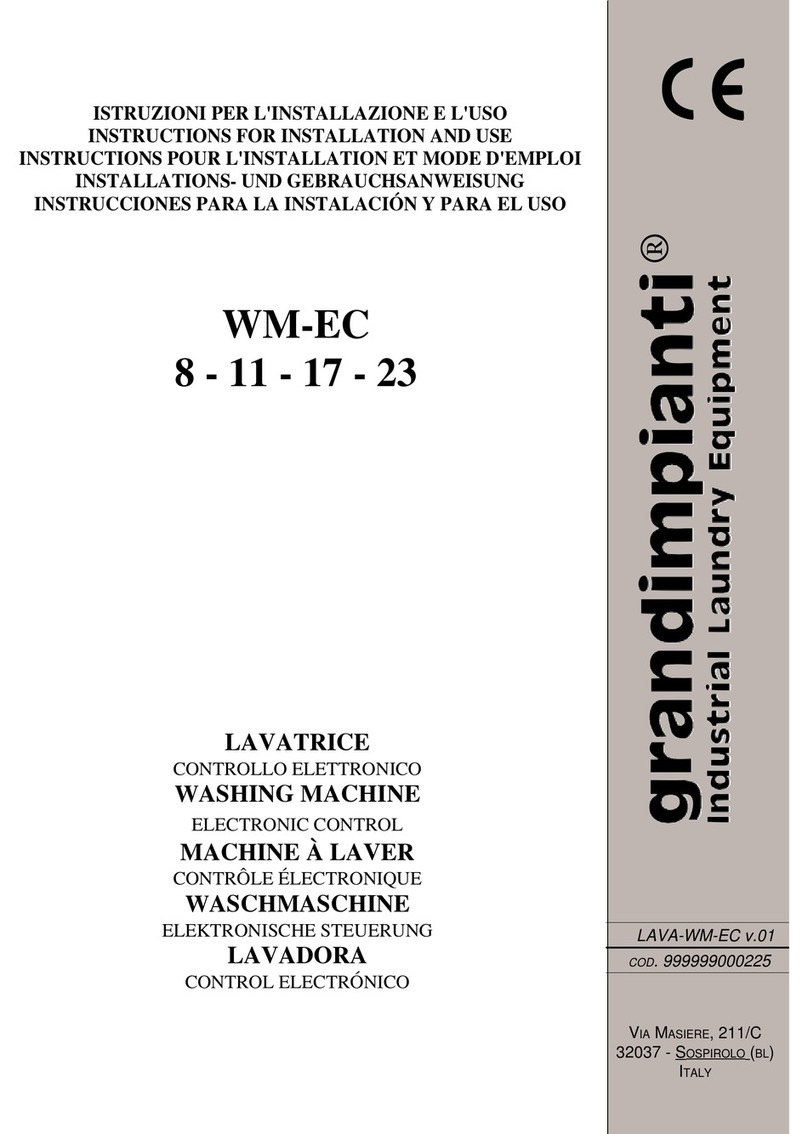
grandimpianti
grandimpianti WM-EC 8 User manual

grandimpianti
grandimpianti GH6V Mounting instructions
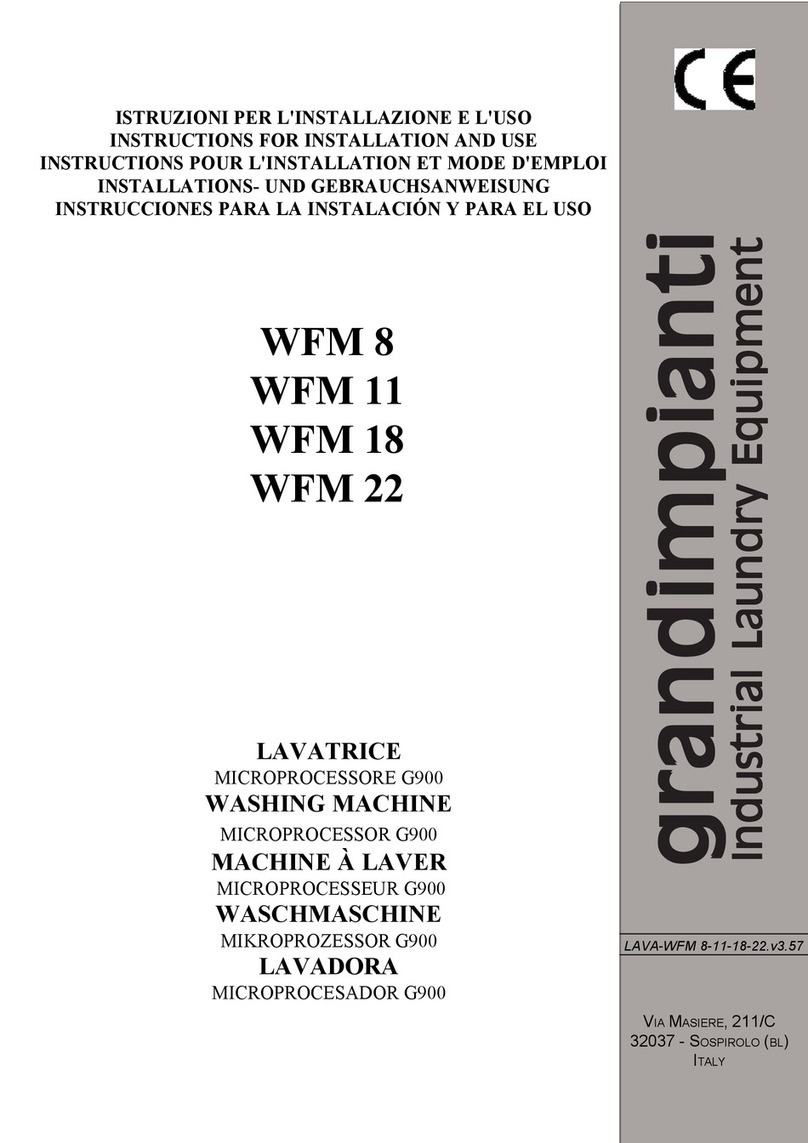
grandimpianti
grandimpianti WFM 8 User manual

grandimpianti
grandimpianti WF 8 User manual
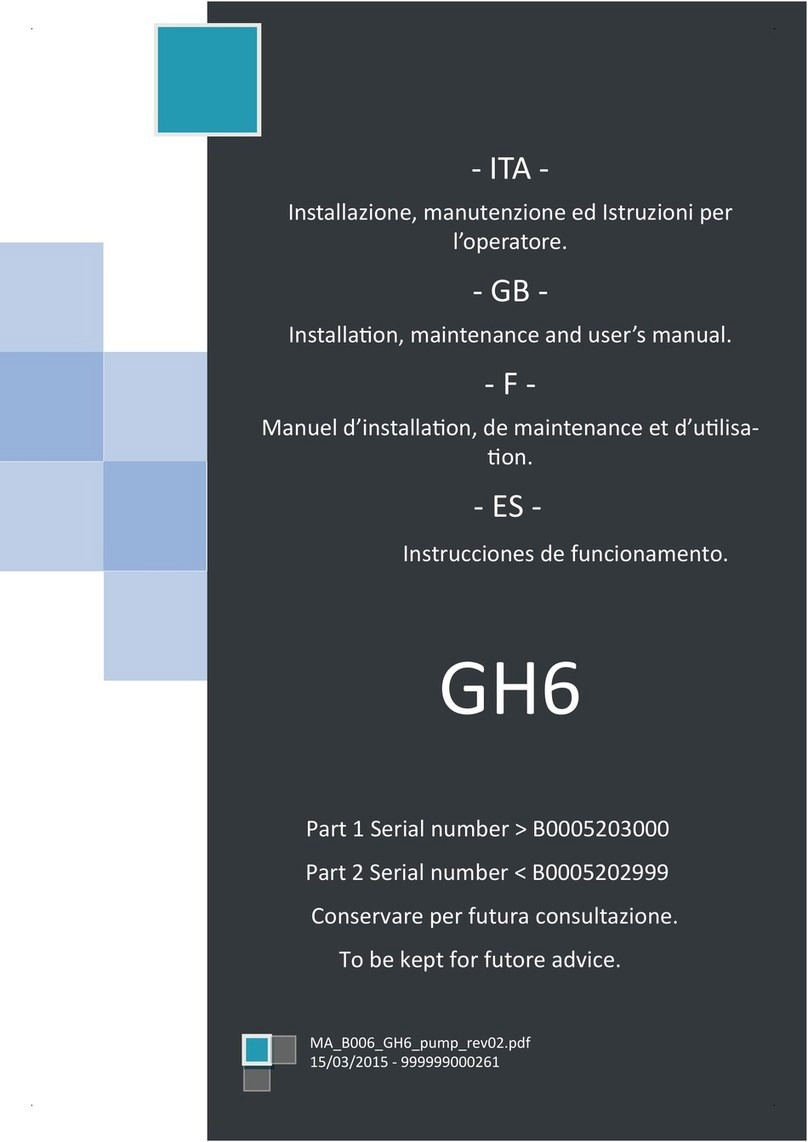
grandimpianti
grandimpianti GH6 Mounting instructions

grandimpianti
grandimpianti GH6 User manual

grandimpianti
grandimpianti BTEL15*N4065 Owner's manual
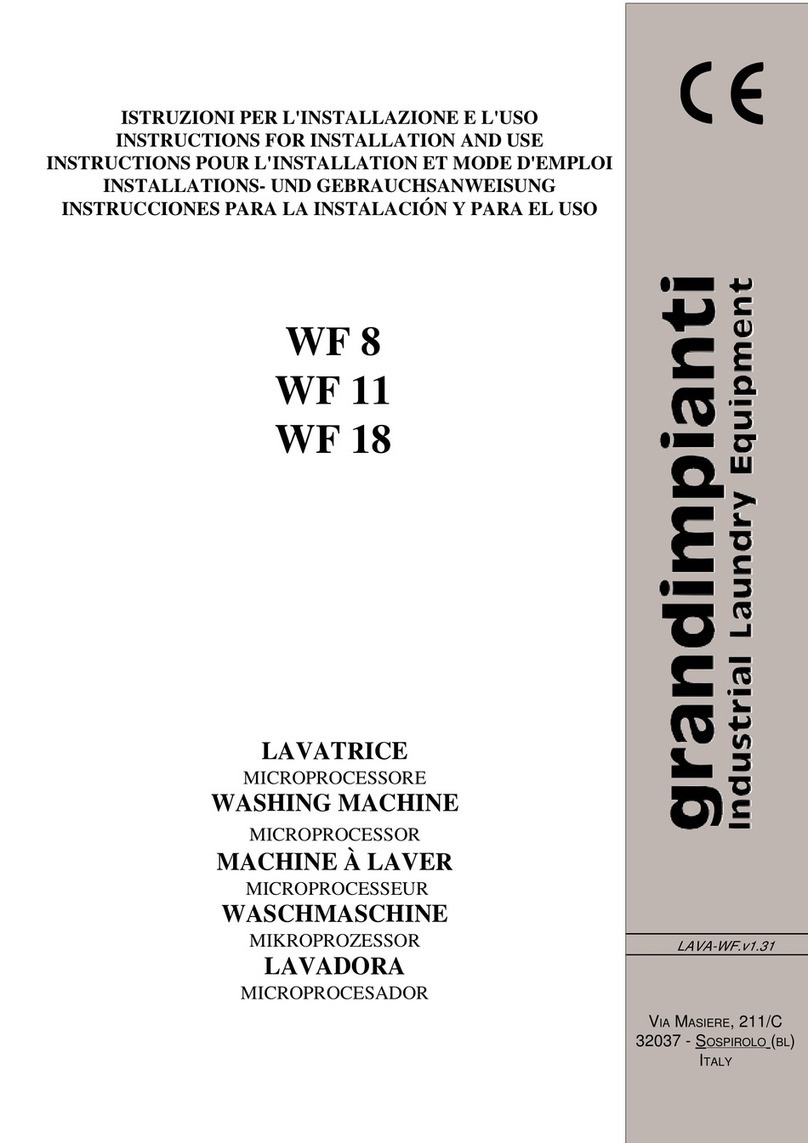
grandimpianti
grandimpianti WF 8 User manual

grandimpianti
grandimpianti WMC 81 User manual

